2012年秋学期新教材外研版七年级英语上册复习课件全册(含语法讲解和精选习题)(共157张PPT)
文档属性
| 名称 | 2012年秋学期新教材外研版七年级英语上册复习课件全册(含语法讲解和精选习题)(共157张PPT) | 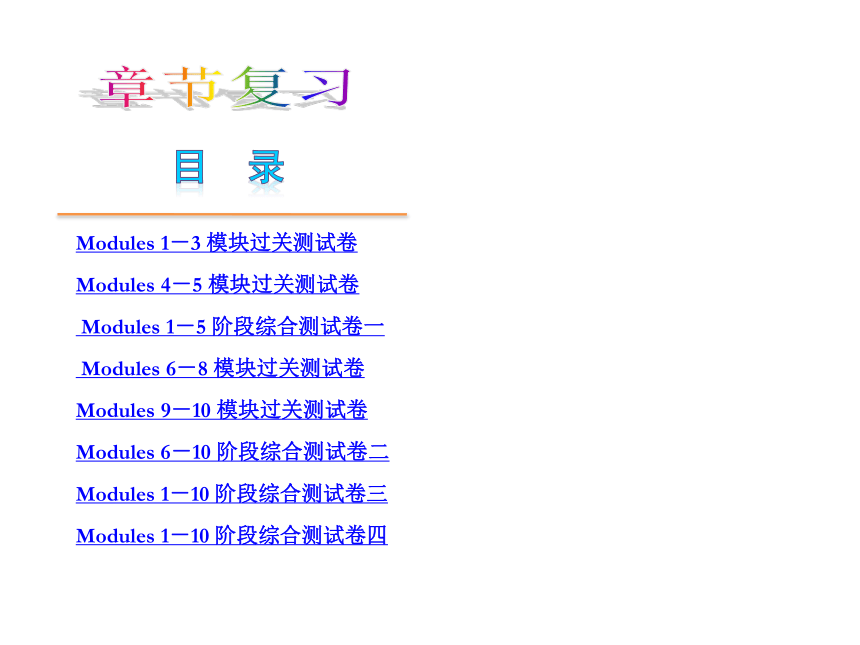 | |
| 格式 | zip | ||
| 文件大小 | 271.9KB | ||
| 资源类型 | 教案 | ||
| 版本资源 | 外研版 | ||
| 科目 | 英语 | ||
| 更新时间 | 2012-10-17 22:23:05 | ||
图片预览

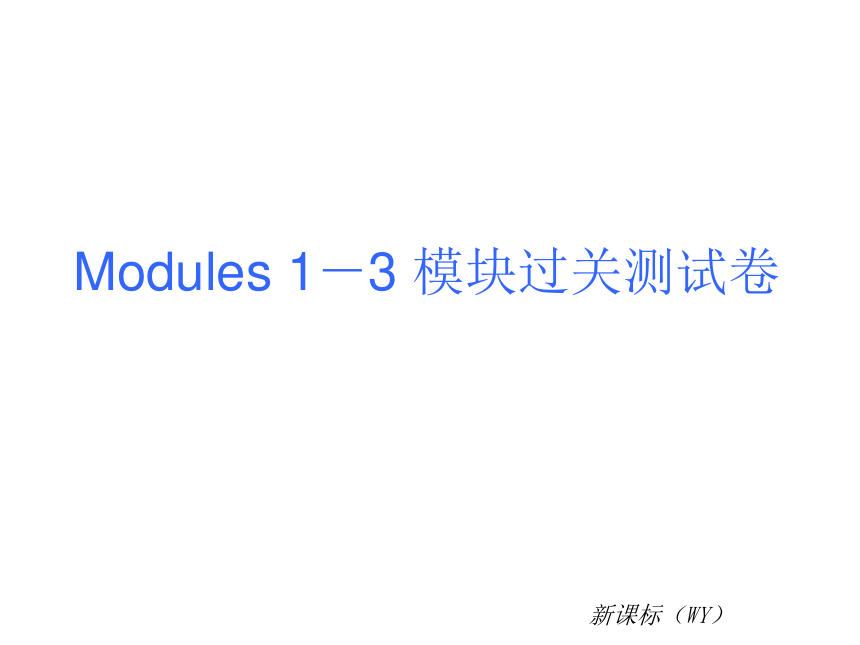
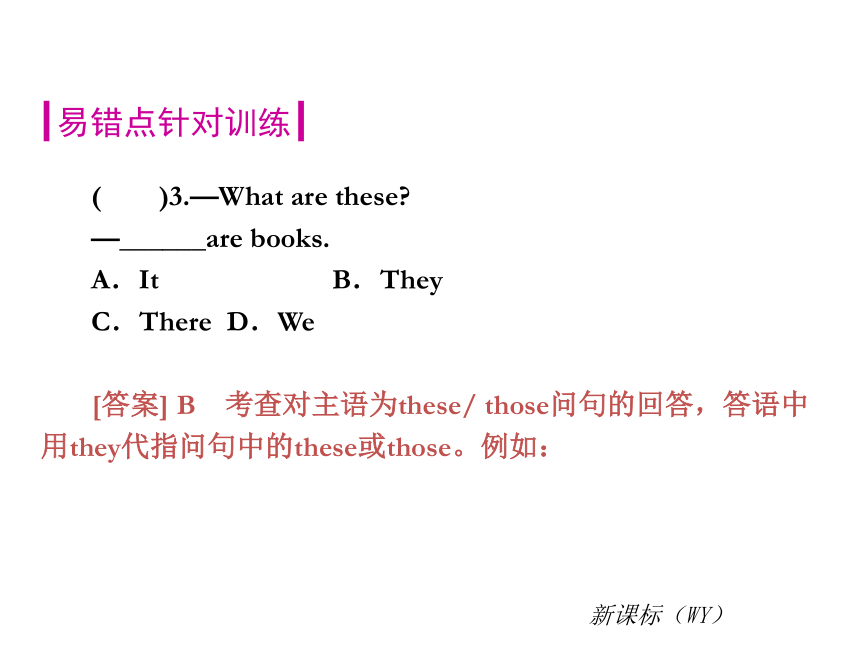
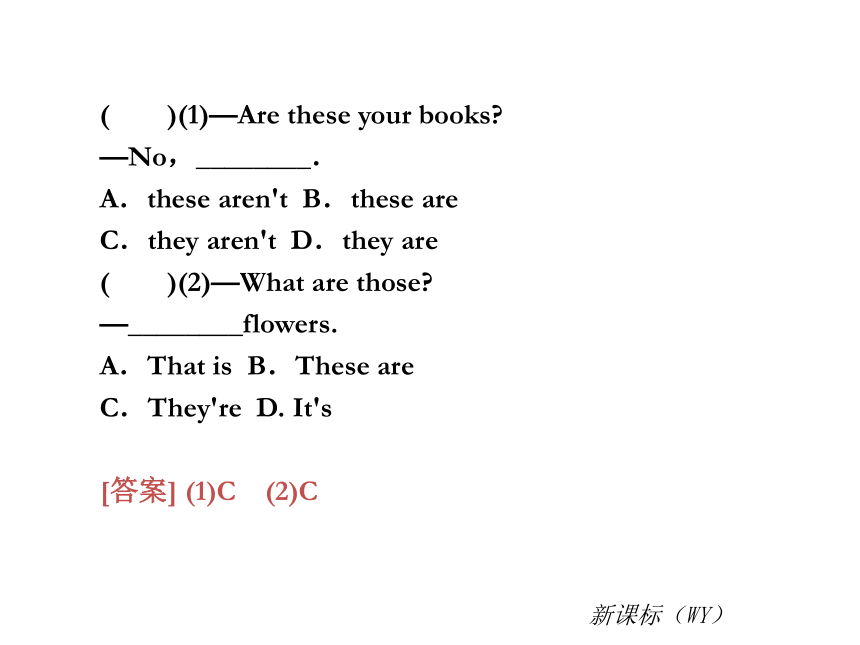
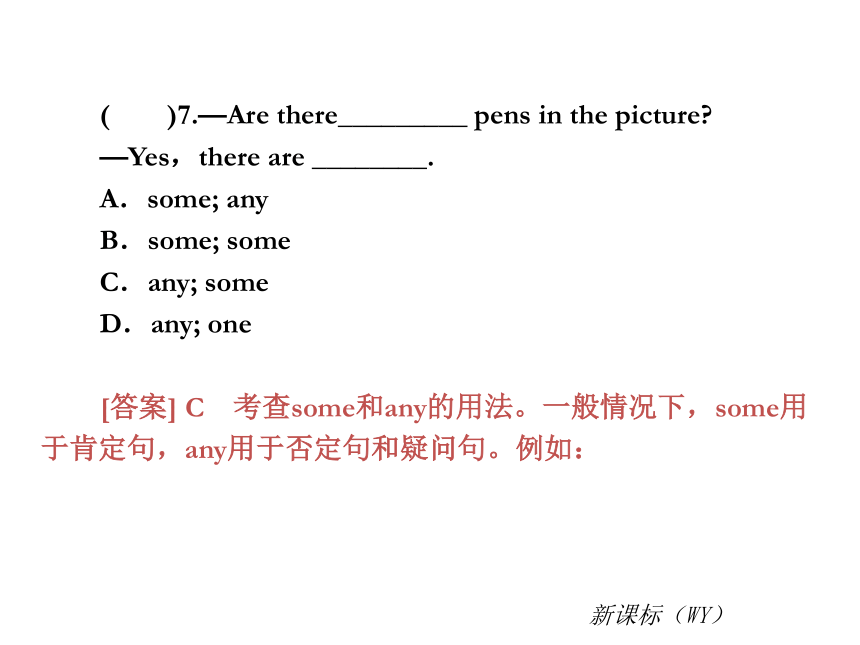
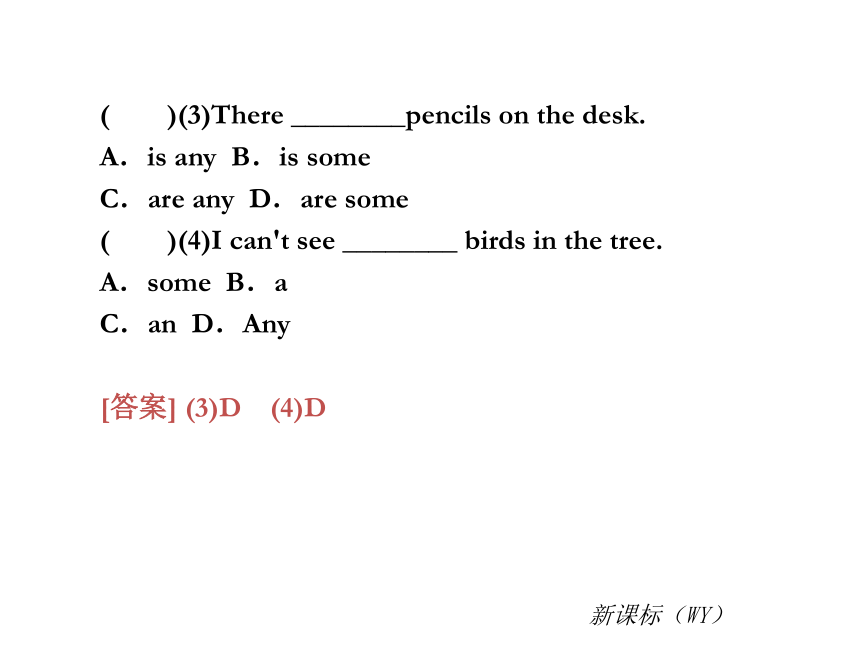
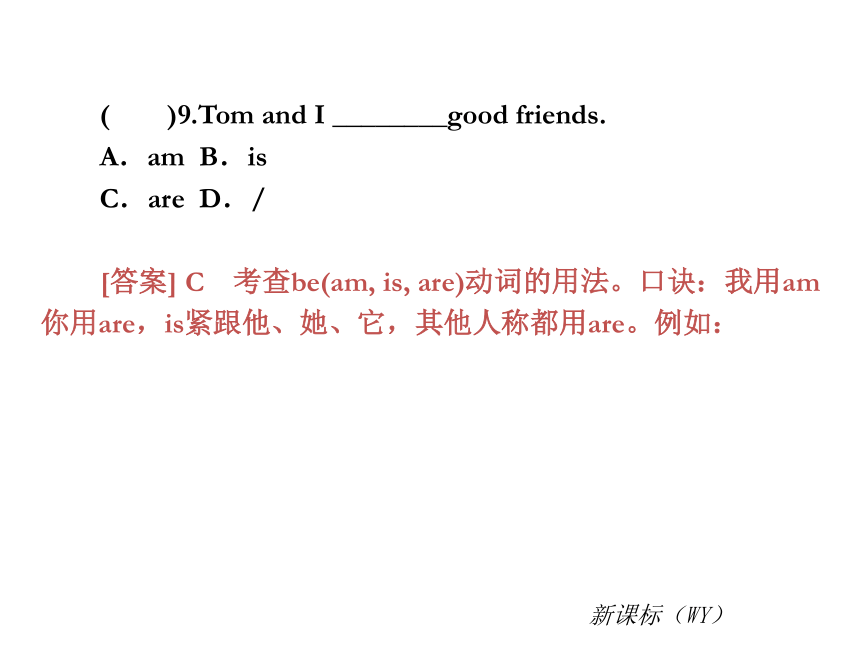
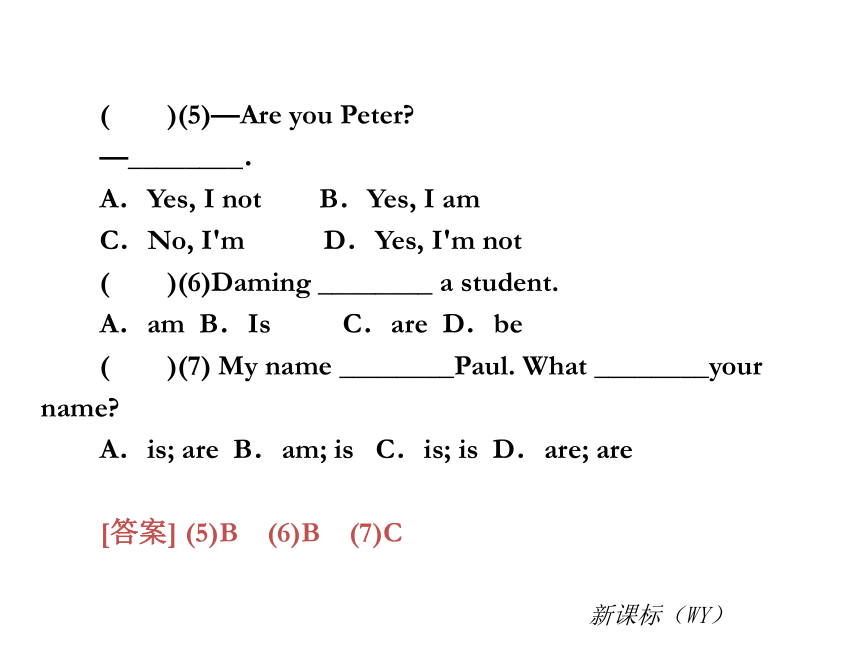
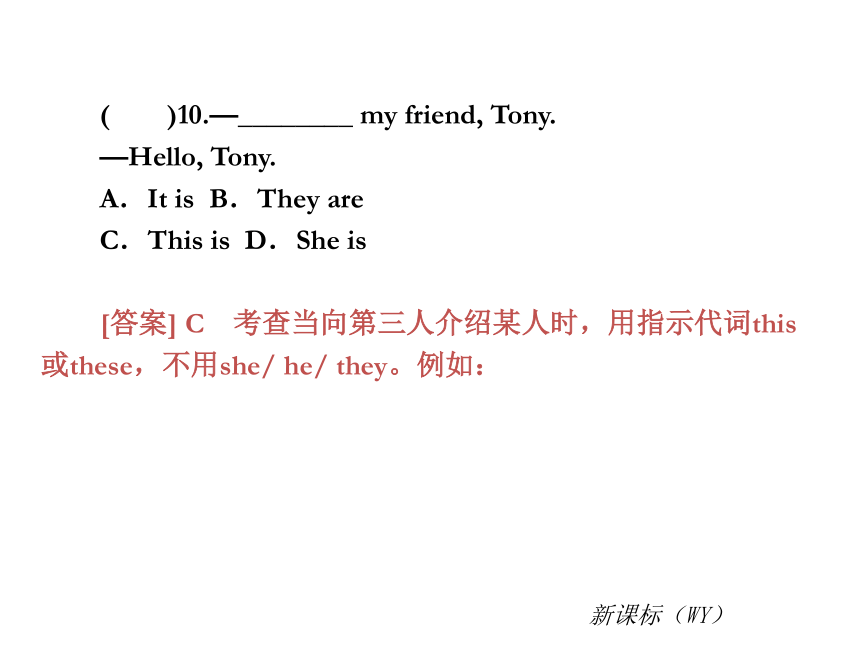

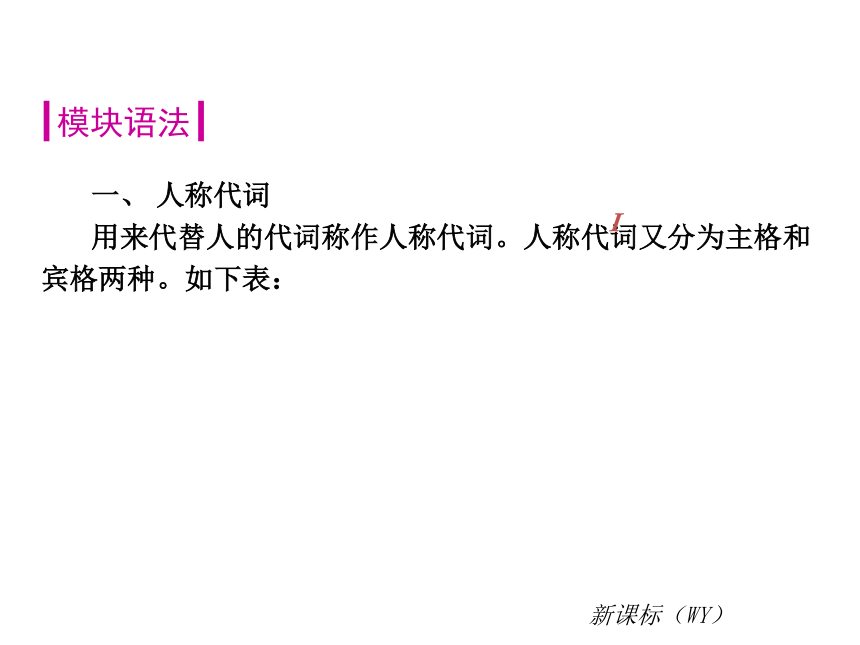
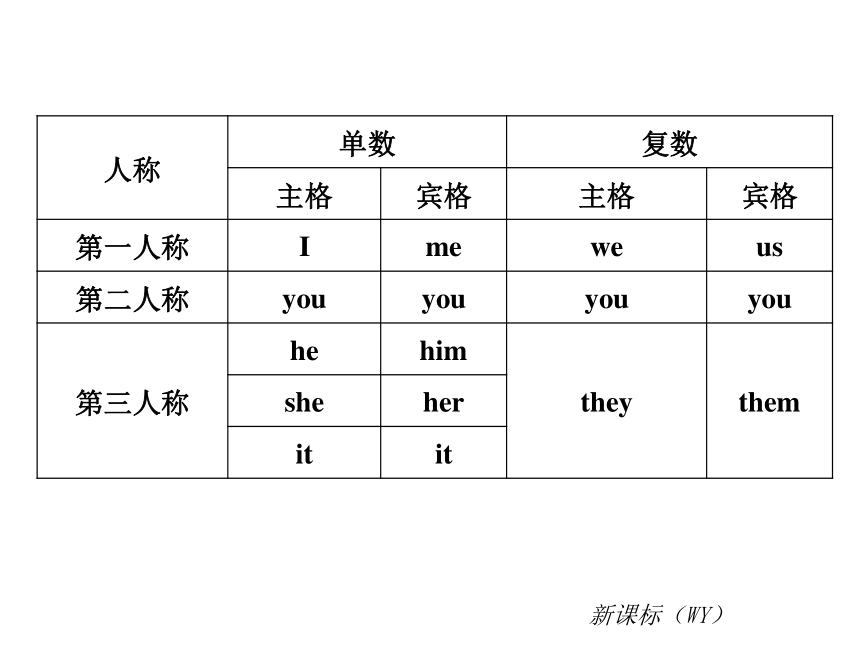
文档简介
(共157张PPT)
Modules 1-3 模块过关测试卷
Modules 4-5 模块过关测试卷
Modules 1-5 阶段综合测试卷一
Modules 6-8 模块过关测试卷
Modules 9-10 模块过关测试卷
Modules 6-10 阶段综合测试卷二
Modules 1-10 阶段综合测试卷三
Modules 1-10 阶段综合测试卷四
Modules 1-3 模块过关测试卷
新课标(WY)
( )3.—What are these
—______are books.
A.It B.They
C.There D.We
[答案] B 考查对主语为these/ those问句的回答,答语中用they代指问句中的these或those。例如:
┃易错点针对训练┃
Modules 1-3 模块过关测试卷
新课标(WY)
( )(1)—Are these your books
—No,________.
A.these aren't B.these are
C.they aren't D.they are
( )(2)—What are those
—________flowers.
A.That is B.These are
C.They're D. It's
[答案] (1)C (2)C
Modules 1-3 模块过关测试卷
新课标(WY)
( )7.—Are there_________ pens in the picture
—Yes,there are ________.
A.some; any
B.some; some
C.any; some
D.any; one
[答案] C 考查some和any的用法。一般情况下,some用于肯定句,any用于否定句和疑问句。例如:
Modules 1-3 模块过关测试卷
新课标(WY)
( )(3)There ________pencils on the desk.
A.is any B.is some
C.are any D.are some
( )(4)I can't see ________ birds in the tree.
A.some B.a
C.an D.Any
[答案] (3)D (4)D
Modules 1-3 模块过关测试卷
新课标(WY)
( )9.Tom and I ________good friends.
A.am B.is
C.are D./
[答案] C 考查be(am, is, are)动词的用法。口诀:我用am你用are,is紧跟他、她、它,其他人称都用are。例如:
Modules 1-3 模块过关测试卷
新课标(WY)
( )(5)—Are you Peter
—________.
A.Yes, I not B.Yes, I am
C.No, I'm D.Yes, I'm not
( )(6)Daming ________ a student.
A.am B.Is C.are D.be
( )(7) My name ________Paul. What ________your name
A.is; are B.am; is C.is; is D.are; are
[答案] (5)B (6)B (7)C
Modules 1-3 模块过关测试卷
新课标(WY)
( )10.—________ my friend, Tony.
—Hello, Tony.
A.It is B.They are
C.This is D.She is
[答案] C 考查当向第三人介绍某人时,用指示代词this或these,不用she/ he/ they。例如:
Modules 1-3 模块过关测试卷
新课标(WY)
( )(8) Mum, ________are my good friends.
A.this B.that
C.these D.It
[答案] C
Modules 1-3 模块过关测试卷
新课标(WY)
一、 人称代词
用来代替人的代词称作人称代词。人称代词又分为主格和宾格两种。如下表:
┃模块语法┃
Modules 1-3 模块过关测试卷
I
新课标(WY)
Modules 1-3 模块过关测试卷
人称 单数 复数
主格 宾格 主格 宾格
第一人称 I me we us
第二人称 you you you you
第三人称 he him they them
she her
it it
新课标(WY)
1.人称代词主格:在句子中作主语的代词。
(1)主格在句中作主语,常置于句首。例如:
I am in Class Two.
我在二班。
He is twelve years old.
他今年12岁了。
(2)多个人称代词连用时的排列顺序是:
①单数:第二人称(you)+第三人称(he/she/it)+第一人称(I),例如:
You,he and I are students.
我、你和他都是学生。
Modules 1-3 模块过关测试卷
新课标(WY)
②复数:第一人称(we)+第二人称(you)+第三人称(they),例如:
We and they are from Hainan.
我们和他们来自海南。
③名词与代词混用: 名词+人称代词,例如:
Miss Yang and he are good friends.
他和杨老师是朋友。
④主动承认错误时,第一人称在前,例如:
I and John made the teacher angry.
我和约翰惹老师生气了。
2.人称代词宾格:在句中作宾语的代词。
Modules 1-3 模块过关测试卷
新课标(WY)
(1)宾格在句中作宾语,常放在动词或介词后。例如:
He is a good boy and we like him.
他是一个好孩子,我们都很喜欢他。
(2)人称代词的宾格在口语中也能作表语。例如:
—Who broke the vase 谁打碎了花瓶?
—Me. 我。(Me.=It's me.)
二、动词be的一般现在时
1.am, is, are是动词be的一般现在时形式,基本意思为“是”,用来说明某人的年龄、身份、身体状况等,在英语中起着非常重要的作用。一般现在时的基本用法归纳如下:
(1)肯定句式为:主语+am/is/are+其他,例如:
Modules 1-3 模块过关测试卷
新课标(WY)
I am a student.
我是一名学生。
He's a doctor.
他是一位医生。
It's a desk.
它是一张桌子。
They are my friends.
他们是我的朋友。
(2)动词be的否定式就是在其后加not,且可以缩写为“isn't, aren't”,其中am与not不能缩写。例如:
He is not a teacher.→He isn't a teacher.
Modules 1-3 模块过关测试卷
新课标(WY)
他不是一名教师。
You are not Chinese.→You aren't Chinese.
你们不是中国人。
I'm not your friend.
我不是你的朋友。
(3)be动词的一般疑问式是把be动词提至句首,第一个字母要大写,句末用问号。肯定回答为“Yes,主语+be”,否定回答为“No,主语+be not”。例如:
—Is this a map
这是一张地图吗?
—Yes, it is.
Modules 1-3 模块过关测试卷
新课标(WY)
是的,它是。
—Are they from Xinjiang
他们来自新疆吗?
—No, they aren't.
不,他们不是。
注意:它们的用法随人称和数的不同而变化,可记住下列口诀,避免出错。“我(I)用am,你(you)用are, is 连接他(he)、她(she)、它(it)。单数词用is,复数词全用are。”
2.在一般现在时的表达中关于动词be的常用句式:
(1)be+形容词,例如:
I am very happy.
Modules 1-3 模块过关测试卷
新课标(WY)
我很幸福。
The fruit is very nice.
这水果很新鲜。
(2)be+名词,例如:
Mr Wang is our English teacher.
王先生是我们的英语老师。
They are our friends.
他们是我们的朋友。
(3)be+介词短语(in,on…),例如:
The book is on the desk.
书在桌子上。
Modules 1-3 模块过关测试卷
新课标(WY)
Are they from America
他们来自美国吗?
(4)be+形容词短语,例如:
He is only four years old. 他只有四岁。
(5)be+副词,例如:
Class is over.下课了。
Modules 1-3 模块过关测试卷
新课标(WY)
Module 2
一、 指示代词this,that,these,those的用法
this,that,these,those四个词都是指示代词,分别表示“这个”,“那个”,“这些”,“那些”。
1.this 用来指离说话者位置近的人或者物,以及时间上较近的场合。例如:
This is my mother.
这是我妈妈。
2.that用来指在空间或时间上离的较远的人、物和场合。例如:
Modules 1-3 模块过关测试卷
新课标(WY)
That is my father.
那是我爸爸。
3.these是this的复数形式,those是that的复数形式。this,that和is连用,而these,those和are连用。this is,these are,those are不存在缩写形式,只有that is有缩写形式,即that's。例如:
These are my friends.
这些是我的朋友。
Those are their aunts.
那些是他们的姑姑。
That's his father.
Modules 1-3 模块过关测试卷
新课标(WY)
= That is his father.
那是他父亲。
指示代词的一般疑问句形式直接将be动词提前到句首,把第一人称转换为第二人称,回答用yes或no。而在回答主语为this,that,these,those的疑问句时,问句中的this,that在答语中要用it替代,these,those要用they替代。例如:
—Is this his father
—Yes, it is. / No, it isn't.
—Are these your friends
—Yes, they are. / No, they aren't.
Modules 1-3 模块过关测试卷
新课标(WY)
二、 名词所有格
本模块出现了一些这样的短语:Daming's mother,Tony's father 等,英语中这种“名词+'s”表示后面的名词与这个名词是所属关系,被称为名词所有格。
1.名词所有格的构成:
(1)一般情况下名词词尾加“'s”,表示“……的”。例如:
Mary's mother 玛丽的妈妈。
(2)若名词词尾已有 s,只加“'”。例如:
the teachers' office 老师们的办公室。
(3)在不以 s 或 es结尾的复数名词后,加“'s”构成所有格。例如:
Modules 1-3 模块过关测试卷
新课标(WY)
Children's Day儿童节。
(4)表示无生命物体的所有格,要用of。例如:
a map of China 一张中国地图。
(5)表示时间、距离的名词,所有格也由词尾加“'s” 构成。例如:
today's newspaper 今天的报纸。
2.使用名词所有格应注意的问题:
(1)如果两个名词并列,并且分别有“'s”,则表示“分别所有”;只有一个“'s”,则表示“共有”。例如:
John's and Mary's rooms(表示两个房间),
John and Mary's room(表示一个房间)。
Modules 1-3 模块过关测试卷
新课标(WY)
(2)在表示店铺、医生诊所或教堂、某人的家时,名词所有格的后面常常不出现它所修饰的名词。例如:
the barber's理发店,
at Uncle Wang's 在王叔叔家。
Modules 1-3 模块过关测试卷
新课标(WY)
Module 3
there be 句型结构
1.结构陈述:
there be 句型表示某处有某人或某物。常用结构为:there is/are +某人/某物+地点状语。例如:
There is a computer on the desk.
桌子上有一台电脑。
There are twenty students in the classroom.
Modules 1-3 模块过关测试卷
新课标(WY)
教室里有20个学生。
2.谓语动词:
在there be 句型中,be为谓语动词,它在人称和数上应与其临近的主语保持一致。
(1) 若主语为单数或不可数名词,be动词用is。例如:
There is a photo of a star on the wall.
墙上有一张明星照。
(2)若主语是可数名词复数,be动词用are。例如:
There are many animals in the zoo.
动物园里有许多动物。
Modules 1-3 模块过关测试卷
新课标(WY)
(3)若有多个主语并列时,谓语动词一般采用“就近原则”。例如:
There is a boy and four girls in our classroom. 教室里有一个男孩和四个女孩。
There are four girls and a boy in our classroom. 教室里有四个女孩和一个男孩。
3.句型转换:
there be 句型变否定句时在be 后加not,变一般疑问句时将be提至句首。同时,some变成any。对数字提问时,要用how many;对整个主语进行提问时,主语是物,则用what,主语是人则用who。例如:
Modules 1-3 模块过关测试卷
新课标(WY)
There is a bird in the tree.(改为否定句)
There isn't a bird in the tree.
There are some trees behind the house.(改为一般疑问句,并作否定回答)
—Are there any trees behind the house
—No,there aren't.
There are three apples in the box. (对画线部分提问)
How many apples are there in the box
There is a_computer on the desk.(对画线部分提问)
What is on the desk
Modules 1-3 模块过关测试卷
新课标(WY)
4.there be句型与have(has)got的区别:
there be 句型与have(has)got同为“有”的意思,但用法有区别。there be结构表示“某地存在某物”; have(has)got 表示“某人有某物”。例如:
There is an orange in the box.
盒子里有一个橘子。 (表示存在)
Tony has got a car.
托尼有一辆汽车。(表示某人拥有)
Modules 1-3 模块过关测试卷
新课标(WY)
Modules 4-5 模块过关测试卷
新课标(WY)
( )5.Grandma always ________me a story when I go to bed.
A.tells B.tell
C.telling D.Told
[答案] A
┃易错点针对训练┃
Modules 4-5 模块过关测试卷
新课标(WY)
( )6.Kate and Lily ________maths.
A.not like B.likes
C.liking D.don't like
[答案] D 考查含有行为动词的一般现在时态。表达经常性或习惯性的动作,或者表示现在的状态,用一般现在时。第一人称和第二人称及第三人称的复数形式一般现在时态谓语动词没有变化,否定形式在谓语动词前加助动词don't。第三人称单数形式的否定形式在谓语动词前加助动词doesn't,谓语动词变为原形。例如:
Modules 4-5 模块过关测试卷
新课标(WY)
( )(1)They ________at six o'clock in the evening.
A.do their homework B.does their homework
C.do his homework D.does his homework
( )(2) I often ________at seven in the morning.
A.has breakfast B.has a breakfast
C.have breakfast D.have a breakfast
[答案] (1)A (2)C
Modules 4-5 模块过关测试卷
新课标(WY)
( )8.—________people in the room
—Yes, there are.
A.Is there a
B.Are there any
C.Is there any
D.Are there some
[答案] B 考查there be句式及some和any的用法。例如:
Modules 4-5 模块过关测试卷
新课标(WY)
( )(3)There ________some milk in the glass.
A.be B.is
C.are D. isn't
[答案] B
Modules 4-5 模块过关测试卷
新课标(WY)
( )14.Onions and carrots are________.
A.fruit B.drinks
C.trees D.Vegetables
[答案] D
Modules 4-5 模块过关测试卷
新课标(WY)
( )15.There are many ________and ________in the basket.
A.melons; tomatoes
B.melones; tomatos
C.melon; tomato
D.melon; tomatoes
[答案] A 考查不可数名词与可数名词的单复数形式。例如:
Modules 4-5 模块过关测试卷
新课标(WY)
( )(4) Have you got any ________?
A.beef B.melon
C.an onion D.chickens
( )(5) ________are my favourite food.
A.Potatos B.Chicken
C.Tomatoes D.Meat
[答案] (4)A (5)C
Modules 4-5 模块过关测试卷
新课标(WY)
Module 4
一、have/has got的用法
1.句式结构:
(1)肯定句: 主语+have/has got …
若主语为非第三人称单数:第一人称(I,we)、第二人称(you),第三人称复数(they)及其他复数名词时,要用have got。若主语为第三人称单数(he,she,it或单数名词)时,要用has got。例如:
┃模块语法┃
Modules 4-5 模块过关测试卷
新课标(WY)
我们有一个新朋友。
We have got a new friend.
他弟弟有一只猫。
His brother has got a cat.
(2)否定句: 变否定句时,在have/has后面加not。have not可缩写为haven't;has not 可缩写为hasn't。例如:
They have not (haven't) got a big family.
他们没有一个大家庭。
His brother has not (hasn't) got a new bike.
他的弟弟没有一辆新自行车。
Modules 4-5 模块过关测试卷
新课标(WY)
(3)一般疑问句: 只要将have/has提至句首就可以变为一般疑问句。回答时,也要用助动词have或has 来回答。例如:
—Have you got a football
—Yes, I have./No, I haven't.
“你有一个足球吗?”
“是的,我有。/不,我没有。”
2.与there be 句型的区别:
there be 句型表达“某地存在某物(人)”,have/has got表达“某人(物)拥有……”。例如:
I have got two ears.
我有两只耳朵。(属于我)
Modules 4-5 模块过关测试卷
新课标(WY)
There is a football under the bed.
床底下有一个足球。(存在于床下)
3.have/has与have/has got的区别:
(1)相同点:两者都表达“有”的意思。只是美国人习惯于用have/has表达这一意思,而英国人常用have/has got来表达。例如:
They have many new books.
他们有许多新书。
John has got a new bike.
约翰有一辆新的自行车。
Modules 4-5 模块过关测试卷
新课标(WY)
(2)不同点:在have/has句式中,have/has是一个实义动词,变否定句或疑问句就不能在其后加not或将have/has 提前。要借用助动词do/does来变化。例如:
They don't have many new books.
他们没有许多书。
—Do they have many new books
—Yes, they do./No, they don't.
“他们有许多书吗?”
“是的,他们有。/不,他们没有。”
二、some与any的用法
Modules 4-5 模块过关测试卷
新课标(WY)
1.相同点:
都表示“一些”;都可修饰可数名词与不可数名词。
2.不同点:
(1)some多用在肯定句中,而any多用于否定句和疑问句中。例如:
There are some apples in the basket.
篮子里有一些苹果。
There isn't any fish in the lake.
湖里没什么鱼。
(2)当征求对方意愿并想得到肯定回答时,some也可用于疑问句中。例如:
Modules 4-5 模块过关测试卷
新课标(WY)
Would you like some juice
您想要一些果汁吗?(表示请求或建议)
(3)当any表示“任何(一个)”时,可以用在肯定句中。例如:
Any day is OK.
任何一天都行。
三、可数名词与不可数名词
1.可数名词变复数的变化规则
(1)一般在名词的词尾加 s, 清辅音后读/s/, 浊辅音和元音后读/z/。例如:
map—maps, bag—bags, car—cars。
Modules 4-5 模块过关测试卷
新课标(WY)
(2)以字母 s, sh, ch, x等结尾的词加 es, 读/iz/。例如:
bus—buses, watch—watches。
(3)以 ce, se, ze 等结尾的词加 s, 读/iz/。例如:license—licenses。
(4)以“辅音字母+ y”结尾的词变 y 为 i, 再加 es, 读/z/。例如:baby-babies。
(5)以“元音字母+ y”结尾的词, 直接加 s。例如:
monkey-monkeys, holiday-holidays。
(6)以字母 o结尾的词多数加 es。例如:
hero—heroes,
Modules 4-5 模块过关测试卷
新课标(WY)
negro—negroes,
tomato—tomatoes,
potato—potatoes。
但下面两类只加 s:
①一些外来词语:photos, pianos, kilos, tobaccos。
②词尾为两个元音字母的词:bamboos,radios, zoos。
(7)以 f或 fe 结尾的名词变复数时,去 f或 fe然后加 ves。例如:
half—halves, knife—knives,leaf—leaves, wolf—wolves。
Modules 4-5 模块过关测试卷
新课标(WY)
(8)名词变复数的几种不规则变化
①不规则变化:man—men,
woman—women, child—children,
foot—feet, tooth—teeth。
②单复数同形:deer, sheep, Chinese, Japanese等。
2.可数名词与不可数名词的用法区别
(1)可数名词单数可用a或an来修饰,而不可数名词则不能直接用,例如:
a cup of tea一杯茶,
two pieces of paper 两张纸。
Modules 4-5 模块过关测试卷
新课标(WY)
(2)可数名词可以用具体的数词来修饰,还可以用few,many,some,a lot of来修饰,表达数量。例如:
two trees, some pens等。
不可数名词前不能直接加数词,但可用some,any,much,a lot of, little来修饰。例如:
some money, much rice, a little water等。
(3)可数名词常用how many来询问数量的多少,不可数名词则用how much来提问。
(4)常见的不可数名词有:
①物质名词:milk, money
②抽象名词:health, youth
Modules 4-5 模块过关测试卷
新课标(WY)
Module 5
一般现在时的用法(一)
一、定义:
1.表示经常性或习惯性的动作, 常与表示频度的时间状语连用。例如:every, often, sometimes, on Sunday, in the morning等。例如:
I leave home for school at 7 every morning.
每天早上七点我离开家去上学。
2.表示客观真理、 客观存在和科学事实。例如:
The earth moves around the sun.
地球围绕太阳转。
Modules 4-5 模块过关测试卷
新课标(WY)
3.用于格言或警句。例如:
Pride goes before a fall. 骄必败。
4.表示现在时刻的状态、能力、性格、个性。
例如:I'm happy.我很高兴。
二、分类:
一般现在时态分为:be动词的一般现在时和实义动词的一般现在时。
1.be 动词的一般现在时态:
(1)肯定句:主语+ be 动词(am/is/are)+表语。例如:
I am a teacher./You are his friends. /She is a nurse.
Modules 4-5 模块过关测试卷
新课标(WY)
(2)否定句:主语+ be 动词(am/is/are)+not+表语。例如:
I am not a teacher./You are not his friends./She is not a nurse.
注意:is not =isn't; are not=aren't; am not 没有简写形式。
(3)一般疑问句: be 动词(Am/Is/Are)+主语+表语?例如:
—Are you a teacher
—Yes, I am./No, I'm not.
—Are you his friends
Modules 4-5 模块过关测试卷
新课标(WY)
—Yes, we are./No, we aren't.
—Is she a nurse
—Yes, she is./No, she isn't.
2.实义动词的一般现在时态:
实义动词的一般现在时分为主语是非第三人称单数和第三人称单数两种。本模块我们学习主语是非第三人称单数的一般现在时形式。
Modules 4-5 模块过关测试卷
新课标(WY)
(1)肯定句:主语 + 动词原形 + 宾语。例如:
I live far away from school.
我住得离学校很远。
(2)否定句:主语 + 助动词 don't + 动词原形 + 宾语。例如:
I don't live far away from school.
我住得离校不远。
(3) 疑问句:Do + 主语 + 动词原形 + 宾语?例如:
—Do you live far away from school
—Yes, I do./No, I don't.
Modules 4-5 模块过关测试卷
新课标(WY)
“你住得离学校远吗?”“远。/不远。”
注意:do除作助动词之外,还可用作实义动词,意为“做”。例如:do one's homework做作业, do housework 做家务。此时由肯定句变否定句时,不能在原句中的动词do后直接加not,而应在do前再加don't(doesn't)。例如:
My parents do housework in the evening.
我的父母在晚上做家务。
My parents don't do housework in the evening.
我的父母在晚上不做家务。
Modules 4-5 模块过关测试卷
新课标(WY)
Modules 1-5 阶段综合测试卷一
新课标(WY)
听力部分 一键下载:http:∥zk./2012/tl.html
Ⅰ.听句子,选出与所听句子内容相符的图片,每个句子读一遍
1.Jackie Chan is from China. He's an actor.
2.Betty can play the piano.She plays it very well.
3.Lingling is from China.She is Chinese.
4.Mr Li works in a hospital. He's a doctor.
5.Daming's mother is a doctor.She works in the People's Hospital.
┃听力原文┃
Modules 1-5 阶段综合测试卷一
新课标(WY)
Ⅱ.听句子,选答语,每个句子读一遍
6.Where are you from
7.Has he got any dogs
8.Has Tom got a big family or a small family
9.What's your favourite sport in summer
10.Can your mother talk in English
Modules 1-5 阶段综合测试卷一
新课标(WY)
Ⅲ.听对话,选答语,对话读两遍
M: Mum,what's for our dinner this evening
W: Let me see, John. We have got two carrots and three onions in the fridge.
M: Have we got any fish or beef
W: We've got some fish and chicken, but we haven't got any beef.
M: It's OK. Dad likes eating chicken. Fish is my favourite. What about drink
W:We have milk and juice.
M: Let's cook our dinner.
Modules 1-5 阶段综合测试卷一
新课标(WY)
Ⅷ.听短文,根据所听到的信息完成表格,短文读两遍
Hello, everyone! My name is Lucy, and I'm 15 years old. I'm English, and I'm from the biggest city in America—New York. I like reading and listening to music. My favourite food is noodles. I like doing sports, too. My favourite sport is tennis, and I can play tennis very well. I want to make some friends here in China.
Modules 1-5 阶段综合测试卷一
新课标(WY)
( )18.There ________a pen and two books on David's desk.
A.is B.are
C.am D.Be
[答案] A 考查there be句式的就近一致原则。例如:
┃易错点针对训练┃
Modules 1-5 阶段综合测试卷一
新课标(WY)
( )(1)There ________some juice and some vegetables in the fridge.
A.is B. isn't
C.are D.aren't
[答案] A
Modules 1-5 阶段综合测试卷一
新课标(WY)
( )27.—Have they got any apples
—________. They like apples very much.
A.Yes, they have
B.No, they have
C.Yes, they haven't
D.No, they haven't
[答案] A 考查have/has got句式。例如:
Modules 1-5 阶段综合测试卷一
新课标(WY)
( )(2)—Has he ________a car
—Yes, he has.
A.get B.gets
C.to get D.got
[答案] D
( )28.—________girls are there in your class, Daming
—Twenty two.
A.How old B.How much
C.How many D.What
[答案] C 考查特殊疑问词的用法。
Modules 1-5 阶段综合测试卷一
新课标(WY)
( )(3)—________have you got
—Some onions.
A.What B.How
C.Where D.How many
( )(4)—________ peoples are there in your country
—Fifty six.
A.How old B.How much
C.How many D.What
[答案] (3)A (4)C
Modules 1-5 阶段综合测试卷一
新课标(WY)
Modules 6-8 模块过关测试卷
新课标(WY)
( )1.Every day ________people come to visit Beijing Zoo.
A.ten thousands B.ten thousand
C.ten thousand D.ten thousand of
[答案] C 考查hundred, thousand, million, billion等词的用法。当前面有确切的数字时,这些词用原形;当后面紧跟of时,这些词需要加 s。例如:
┃易错点针对训练┃
Modules 6-8 模块过关测试卷
新课标(WY)
( )(1)There are ________people in the park every day.
A.thousand of B.thousands of
C.six thousand of D.six thousands
[答案] B
( )3.Lingling and Daming________the zoo.
A.Visits B.doesn't often visit
C.don't often visit D.not often visit
[答案] C
Modules6-8 模块过关测试卷
新课标(WY)
( )6.He often ________some good presents on his birthday.
A.makes B.gets
C.sends D.Buy
[答案] B
Modules6-8 模块过关测试卷
新课标(WY)
( )13.What________he ________at the weekend
A.do; do B.do; does
C.does; do D.does; does
[答案] C 考查含有行为动词的一般现在时态。表达经常性或习惯性的动作,或者表示现在的状态,用一般现在时。尤其要注意第三人称单数的变化规则。一般疑问句句前用助动词 do或does,后面谓语动词用原形。特殊疑问句为“特殊疑问词+一般疑问句”的语序。例如:
Modules6-8 模块过关测试卷
新课标(WY)
( )(2)—________ the tiger eat meat
—Yes, it does.
A.Do B.Does C .Are D.Is
( )(3) ________Lucy and Lily have a computer game
A.Is B.Do C.Are D.Does
( )(4) My sister________Cola.
A.not like B.don't like
C.isn't like D.doesn't like
[答案] (2)B (3)B (4)D
Modules6-8 模块过关测试卷
新课标(WY)
( )15.I often play computer games______the Internet.
A.in B.at
C.on C.with
[答案] C 考查介词的用法。例如:
Modules6-8 模块过关测试卷
新课标(WY)
( )(5) I know how to connect the monitor _________the computer.
A.of B.in
C.on D.to
( )(6)He comes _________Japan.
A.from B.to
C.of D.With
[答案] (5)D (6)A
Modules6-8 模块过关测试卷
新课标(WY)
Module 6
一般现在时的用法(二)
上一模块我们学习了主语为非第三人称单数的动词的一般现在时,现在我们学习主语为第三人称单数的行为动词的一般现在时。
一、句式结构
┃模块语法┃
Modules 6-8 模块过关测试卷
新课标(WY)
1.肯定句:主语+动词的第三人称单数形式+宾语,例如:
He goes to school on foot every day.
他每天步行去上学。
2.否定句:主语+ doesn't +动词原形+宾语,例如:
He doesn't go to school on foot every day.
他每天不步行去上学。
3.一般疑问句:
(1)一般疑问句常用来询问一件事是否属实,要用yes作肯定回答,no作否定回答。
Modules6-8 模块过关测试卷
新课标(WY)
(2)当主语是第三人称单数时,含有实义动词的一般现在时陈述句变一般疑问句遵循“一加二变”的规则:
“一加”指变一般疑问句时在句首加助动词does;
“ 二变”指句首加助动词之后,原句中实义动词的第三人称单数变为原形,然后把句末的句号变为问号。例如:
She always goes to concerts.
她总去听音乐会。
→Does she always go to concerts
她总去音乐会吗?
The panda likes eating bamboo.
熊猫喜欢吃竹子。
Modules6-8 模块过关测试卷
新课标(WY)
→Does the panda like eating bamboo
熊猫喜欢吃竹子吗?
注意:此类疑问句的简略回答也要用助动词。例如:
Does he play football on Sunday
他在周日踢足球吗?
Yes,he does. / No,he doesn't.
是,他踢足球。/不,他不踢。
二、动词第三人称单数的变化规则
Modules6-8 模块过关测试卷
新课标(WY)
规则动词的第三人称单数形式与名词变复数规则相同:
1.一般在词尾加 s。在清辅音后读/s/,在浊辅音和元音后读/z/,在/t/后读/ts/,在/d/后读/dz/,例如:play→plays, work→works, get→gets。
2.以字母s, x, ch, sh结尾的动词加 es,读/iz/,以o结尾的动词也加 es,读/z/,例如:pass→passes,watch→watches,go→goes。
3.以辅音字母加 y结尾的动词, 先变y为i, 再加 es,读/z/,例如:study→studies, carry→carries。
注意:have 的第三人称单数形式为has,do的第三人称单数形式为does。
Modules6-8 模块过关测试卷
新课标(WY)
Module 7
一般现在时的用法(三)
本模块主要学习含实义动词的一般现在时的特殊疑问句。
含有实义动词的一般现在时的陈述句变一般疑问句前面已经学过,其特殊疑问句的变化也就简单多了。只要把特殊疑问词放在句首,然后加一个一般疑问句就可以了,即“特殊疑问词+一般疑问句”。例如:
When do you have lunch
你们什么时候吃午饭?
Where does he do his homework
他在哪里做作业?
Modules6-8 模块过关测试卷
新课标(WY)
特殊疑问词在句中起引导作用,主要用来询问人或物、时间、地点、原因、数量等。下面给大家列举一下特殊疑问词的功能:
1.what—询问“什么,何物,何事”
2.what time—询问“几点”
3.when—询问“什么时候 ”
4.where—询问“何地,在哪里”
5.who—询问“谁”
6.whose—询问“谁的”
7.why—询问“为什么”
8.how old—提问“年龄多大”
Modules6-8 模块过关测试卷
新课标(WY)
9.how many—提问“可数名词的数量”
10.how much—提问“不可数名词的数量或价钱”
11.how often—提问“做某事的频率”
12.how long—提问“时间多长或某物体的长度”
特殊疑问句不能用yes 或no 来回答,而应根据实际情况来回答。例如:
—How old are you
你多大了?
—I'm twelve years old.
我十二岁了。
注意:有些疑问词作主语时,语序不变。例如:
Modules6-8 模块过关测试卷
新课标(WY)
Who comes from America
谁来自美国?
Modules6-8 模块过关测试卷
新课标(WY)
Module 8
频度副词
一、always, usually, often, sometimes, seldom和never这六个词是英语中常见的频度副词。它们用来表示动作发生的频率(即动作在单位时间里重复次数的多少)。这六个频度副词所表示的动作频率不同:
Modules6-8 模块过关测试卷
新课标(WY)
1.always意为“始终;一直;总是”,在这六个词中频率最高。其频率为100%,表示中间没有间断。其反义词是never。例如:
The students always get up before six o'clock.
学生们总是六点前起床。
2.usually意为“通常”,表示通常如此,很少例外。其频率比always少,约为80%~90%。例如:
He usually comes late.他通常来得很晚。
3.often意为“经常”。强调动作发生的次数具有经常性,但不如usually频繁。例如:
Mr Liu doesn't often drink.
刘先生并不常喝酒。
Modules6-8 模块过关测试卷
新课标(WY)
4.sometimes意为“有时”。表示动作偶尔发生,中间常有间断,频率不及often。可以位于句首,表强调。例如:
We sometimes play football on Sundays.
我们有时星期天踢足球。
5.seldom意为“很少”,频率较低。例如:
We seldom go to school by bus. We usually go there by bike.
我们很少乘车去上学,我们通常是骑车去。
6.never意为“从不,从来没有”。表示动作发生的频率为零。例如:
Modules6-8 模块过关测试卷
新课标(WY)
I never go to school on foot.
我从来不步行上学。
二、 频度副词在句子中的位置
1.放在be动词、情态动词或助动词之后。例如:
He is always late for school.
他总是上学迟到。
You must never tell her.
你千万别告诉她。
2.放在实义动词之前。例如:
They often help others.
他们经常帮助别人。
Modules6-8 模块过关测试卷
新课标(WY)
The sun always rises in the east.
太阳总是在东方升起。
Modules6-8 模块过关测试卷
新课标(WY)
Modules 9-10 模块过关测试卷
新课标(WY)
( )2.The children________piano now.
A.is playing the
B.are playing the
C.play the
D.play a
[答案] B
┃易错点针对训练┃
Modules 9-10 模块过关测试卷
新课标(WY)
( )3.—Is John doing his homework
—No, he________.
A.isn't B.doesn't C.can't D.aren't
[答案] A
( )15.My family ________supper now.
A.are having all
B.all are having
C.is all having
D.are all having
[答案] D 考查现在进行时态。例如:
Modules 9-10 模块过关测试卷
新课标(WY)
( )(1) We are having a party and every one ________a good time.
A.having B.is having
C.are having D.have
( )(2)—________?
—They are watching a football match on TV.
A.What are they doing
B.Where are they going
C.What do they do
D.Where are they doing
[答案] (1)B (2)A
Modules 9-10 模块过关测试卷
新课标(WY)
( )14.Children enjoy________snowmen.
A.make B.to make
C.making D.to making
[答案] C 考查enjoy后接动名词的用法。常用的后面只能接动名词的词还有practise, finish等。例如:
Modules 9-10 模块过关测试卷
新课标(WY)
( )(3) Do you enjoy________ to music
A.listening B.listen
C.to listen D. listened
( )(4) Do you finish ________your homework
A.do B.doing
C.did D.Does
[答案] (3)A (4)B
Modules 9-10 模块过关测试卷
新课标(WY)
Module 9
现在进行时
1.用法
(1)表示此时此刻(指说话人说话时)正在进行的动作。例如:
We are listening to the teacher carefully.
我们正在认真地听老师讲课。
(2)表示现阶段正在进行的动作,说话时动作未必正在进行。例如:
┃模块语法┃
Modules 9-10 模块过关测试卷
新课标(WY)
Mr Green is writing another novel.
格林先生正在写另一部小说。
(说话时未必正在写,只是近期处于写作的状态。)
(3)表示渐变,这样的动词有 get, grow, become, turn, go等。例如:
Spring comes, and the weather is getting warm.
春天来了,天气渐渐变暖和了。
(4)与always等词连用,表示反复发生的动作或持续存在的状态,往往带有说话人的主观感彩。例如:
Modules 9-10 模块过关测试卷
新课标(WY)
You are always going to school late.
你总是上学迟到。
2.基本构成
主语+be +v. ing(现在分词)+其他。
句中的be (am, is, are)要由主语而定。
3.句式
现在进行时不同句式如下:
(1)肯定句:主语 +be + v. ing +其他 例如:
She is writing a book in the study now.
她正在书房写作。
Modules 9-10 模块过关测试卷
新课标(WY)
(2)否定句:主语 +be+not+v. ing+其他 例如:
She is not writing a book in the study now.
她现在不在书房写作。
(3)一般疑问句:Be +主语+ v. ing +其他
肯定回答:Yes,主语+ am/ is /are.
否定回答: No,主语+ am not/ isn't /aren't.
—Is she writing a book in the study now
她现在在书房写作吗?
—Yes, she is.
是的,她现在在书房写作。
—No, she isn't.
不,她不在书房写作。
Modules 9-10 模块过关测试卷
新课标(WY)
(4)特殊疑问句:
特殊疑问词+ be +主语+v. ing+其他 例如:
Where is she writing a book now
她现在在哪里写作?
4.现在分词的变化规则
(1)一般情况下,在动词原形后直接加 ing。例如:
visit→visiting(参观)
look→looking(看)
study→studying(学习)
(2)以不发音字母e结尾的动词,先去掉e,再加 ing。例如:
Modules 9-10 模块过关测试卷
新课标(WY)
write→writing (写)
live→living (生活)
dance→dancing (跳舞)
drive→driving (开车)
revise→revising (复习)
give→giving (给)
注意: 以发音的e结尾的词,不可去e。例如:
see→seeing(看见)
agree→agreeing(同意)
(3)以重读闭音节结尾的动词(包括 r音节),当词尾只有一个辅音字母时,先双写该辅音字母,再加 ing。例如:
Modules 9-10 模块过关测试卷
新课标(WY)
swim→swimming (游泳)
run→running (跑)
sit→sitting (坐)
put→putting (放)
cut→cutting (切割)
plan→planning (计划)
begin→beginning (开始)
stop→stopping (停止)
prefer→preferring (更喜欢)
注意: open→opening(开)不双写n,因为它的第二个音节是非重读音节。fix→fixing(安装)不双写x,因为它的末尾有两个辅音音素/ks/。
Modules 9-10 模块过关测试卷
新课标(WY)
(4)少数以 ie结尾的重读开音节的动词,应将ie变为 y,再加 ing。
die→dying(死) lie→lying(躺)
tie→tying(拴;系)
5.标志性时间词
(1)当“now, at the moment, at this time, at + 时间点”出现时常表示动作正在进行,这时要用现在进行时。例如:
They are playing basketball now.
现在他们正在打篮球。
(2)look, listen,be quiet 等引导的祈使句后面所接的句子常用现在进行时。例如:
Modules 9-10 模块过关测试卷
新课标(WY)
Listen!She is singing an English song.
听!她正在唱英文歌。
(3)表示当前一段时间或现阶段正在进行的动作,且有all the time, this week, these days等时间状语时,常用现在进行时。例如:
We are making model planes these days.
这些天我们在做飞机模型。
(4)描述图片中的人物的动作时,为了表达更生动,也常用现在进行时。 例如:
Look at the picture. The children are flying kites in the park.
看这幅图,那些孩子正在公园放风筝。
Modules 9-10 模块过关测试卷
新课标(WY)
Module 10
一般现在时和现在进行时的比较
1.概念不同
一般现在时表示主语经常性的、有规律的动作或存在的状态,也可表示说话者的能力及自然现象。而现在进行时表示说话时(瞬间)正在进行的动作,也可表示目前或现阶段一直进行的动作。例如:
She often does her homework in the evening.
她经常在晚上做作业。
She is doing her homework now.
现在她正在做作业。
Modules 9-10 模块过关测试卷
新课标(WY)
Tom plays tennis every Sunday.
汤姆每个星期天打网球。
—Where's Tom
汤姆在哪儿?
—He is playing tennis.
他正在打网球。
2.构成不同
一般现在时的句式结构有下列三种情况:
(1)主语+be+其他
(2)主语+实义动词+其他
(3)主语+情态动词+动词原形+其他
Modules 9-10 模块过关测试卷
新课标(WY)
现在进行时的句式结构是:
主语+be(am/is/are) +v. ing +其他
3.标志性时间词不同
一般现在时的时间状语主要有always, usually, often, sometimes, never, every day, on Sundays, in the morning/afternoon/evening等。
现在进行时的时间状语主要有:now,these days,this week,at the moment等,有时句首有“Look!Listen!”或“It's+时刻等词或句子”。例如:
We play football in the afternoon.
下午我们踢足球。(一般现在时)
Modules 9-10 模块过关测试卷
新课标(WY)
My mother is reading a newspaper now.
我妈妈正在看报纸。(现在进行时)
4.其他区别
(1)一般现在时往往不带任何感彩,语气比较肯定。现在进行时常带有一定的感彩,并常与always, often等副词连用。例如:
Mr Li works hard in the factory.
李先生在工厂工作努力。(说明事实,语气比较肯定)
Mr Li is always working hard in the factory.
李先生在工厂工作一直很努力。(表示赞扬)
Modules 9-10 模块过关测试卷
新课标(WY)
(2)表示某种情感、意识(如want,like,know等)的词及表示“有”(have)等动词一般不用于现在进行时,但可用于一般现在时。例如:
我想现在就回家。
误:I am wanting to go home now.
正:I want to go home now.
他有一台电脑。
Modules 9-10 模块过关测试卷
新课标(WY)
误:He is having a computer.
正:He has a computer.
(3)这两种时态所表示的时间范围都可能有“过去—现在—将来”的意味,但相对而言,一般现在时持续的时间较长,甚至无限。而现在进行时持续的时间较短,可能片刻完成。例如:
She comes from Shanghai.
她来自上海。
She is coming from Shanghai.
她正从(或即将从)上海来。
Modules 9-10 模块过关测试卷
新课标(WY)
Modules 6-10 阶段综合测试卷二
新课标(WY)
听力部分 一键下载:http:∥zk./2012/tl.html
Ⅰ.听句子,选出与所听句子内容相符的图片,每个句子读一遍
1.He is lying on the beach and enjoying the sun.
2.Listen! Someone is singing!
3.He is sweeping the floor.
4.Be quiet! The baby is sleeping.
5.Look! The little girl is cooking!
┃听力原文┃
Modules 6-10 阶段综合测试卷二
新课标(WY)
Ⅱ.听句子,选答语,每个句子读一遍
6.What day is it today
7.What are your lessons this morning
8.Where do you play football
9.What about going to the cinema
10.What's your favourite book
Modules 6-10 阶段综合测试卷二
新课标(WY)
Ⅲ.听对话,选答语,对话读两遍
W: Hi, Daming. What day is it today
M: It's Friday.
W: Friday?Oh, it's Tony's birthday. What do you usually send him
M: I often send him a birthday card. And we often have a party for him at school. What would you like to give him
W: I'd like to give him a box of chocolates.
M: Chocolates Tony never eats chocolates.
W: Really What does he like
M: He likes going to the cinema.
Modules 6-10 阶段综合测试卷二
新课标(WY)
W: Oh, I'd like to send him a cinema ticket.
M: That's a good idea.
Ⅷ.听短文,根据所听到的信息完成表格,短文读两遍
Mr Green is a doctor. He is 30 years old. He likes reading and he often reads lots of books and magazines. He doesn't go to the cinema, but he watches some films on TV at home. He goes to work from Tuesday to Friday. He doesn't have breakfast or lunch at home. He has them in the hospital's dining hall. But he has dinner at home. He usually wears shirts. He likes jeans, but he never wears them.
Modules 6-10 阶段综合测试卷二
新课标(WY)
( )17.We go home________5:30________the afternoon.
A.in; at B.at; in
C.on; at D.in; in
[答案] B 考查介词的用法。(用法前面已举例)
┃易错点针对训练┃
Modules 6-10 阶段综合测试卷二
新课标(WY)
( )18.Mike is ________a postcard ______ his friend.
A.sending; to
B.buying; to
C.taking; for
D.sending; from
[答案] A
Modules 6-10 阶段综合测试卷二
新课标(WY)
( )20.Betty and Lucy are ________some beautiful photos.
A.making B.Take C.taking D.Make
[答案] C 考查现在进行时态。(用法前面已举例)
( )19.—What lessons do you like
—I like English,________I don't like history.
A.and B.Or C.but D.So
[答案] C 考查连词的用法。例如:
Modules 6-10 阶段综合测试卷二
新课标(WY)
( )(1) I don't like swimming ________running.
A.and B.or
C.but D.so
( )(2) My daughter likes eating apples _________melons.
A.and B.or
C.but D.So
[答案] (1)B (2)A
Modules 6-10 阶段综合测试卷二
新课标(WY)
( )22.—It's time to ________!Good night, Kate!
—Good night, Mum!
A.go to school
B.go home
C.get up
D.go to bed
[答案] D 考查It's time to do sth.=It's time for sth. 例如:
Modules 6-10 阶段综合测试卷二
新课标(WY)
( )(3) Be quiet, please! It's time ________ class.
A.for B.to
C.at D.in
( )(4) It's time ________have lunch.
A.for B.to
C.at D.In
[答案] (3)A (4)B
Modules 6-10 阶段综合测试卷二
新课标(WY)
( )23.—________do you go to the football match
—Once a month.
A.How long
B.How old
C.How much
D.How often
[答案] D
Modules 6-10 阶段综合测试卷二
新课标(WY)
( )24.—________do you often do your homework
—At seven o'clock in the evening.
A.Where B.How
C.What D.When
[答案] D 考查特殊疑问词的用法。(用法前面已举例)
Modules 6-10 阶段综合测试卷二
新课标(WY)
( )25.There ________some milk and eggs on the table.
A.is B.are C.has D.Have
[答案] A 考查there be句式的就近一致原则。(用法前面已举例)
( )26.—Mum, there are so many T shirts in this store.
—Yes, let me________one for you.
A.choose B.send C.give D.make
[答案] A 考查let sb. do sth.句式。例如:
Modules 6-10 阶段综合测试卷二
新课标(WY)
( )(5) It's six o'clock now. let's ________ home.
A.go to B.go
C.goes D.going
( )(6) The teacher let the students ________ the new words.
A.read B.reads
C.reading D.to read
[答案] (5)B (6)A
Modules 6-10 阶段综合测试卷二
新课标(WY)
( )27.—What do you think of Lucia
—I love her. She is really________ from other girls.
A.healthy
B.great
C.happy
D.different
[答案] D 考查形容词的用法。例如:
Modules 6-10 阶段综合测试卷二
新课标(WY)
( )(7) Candies and Coke ________food and juice.
A.is healthy
B.is unhealthy
C.are healthy
D.are unhealthy
答案] D
Modules 6-10 阶段综合测试卷二
新课标(WY)
Modules 1-10 阶段综合测试卷三
新课标(WY)
听力部分 一键下载:http:∥zk./2012/tl.html
Ⅰ. 听句子,选出与所听句子内容相符的图片,每个句子读一遍
1.I like swimming.I often go swimming with my friends after work.
2.I want to buy a T shirt for my son. Can I have a look at the red one
┃听力原文┃
Modules 1-10 阶段综合测试卷三
新课标(WY)
3.Fruit is good for our health.And apples are my favourite.
4.I want to join the music club. I can play the violin.
5.I have a nice watch!I got it from my aunt for my birthday.
Ⅱ.听句子,选答语,每个句子读一遍
6.How do you do
7.Is your father at home
8.When does he have lunch
9.Let's go to the cinema!
10.What's your favourite sport
Modules 1-10 阶段综合测试卷三
新课标(WY)
Ⅲ.听对话,选答语,对话读两遍
W: Can I help you?
M: Yes, please. I want to buy something for Father's Day.
W: OK. How about the black T shirt
M: He has a T shirt in that colour.
W: What about the red one
M: It's good. How much is it
W: It's 20 dollars.
M: I don't have much money.
W: How much do you have
M: About ten dollars. That's all I have.
Modules 1-10 阶段综合测试卷三
新课标(WY)
W: Hmm, how about this hat
M: It's really nice. But the price of the hat is 13 dollars.
W: Well, the hat is on sale now. It's only ten dollars.
M: OK, thanks. I'll take it.
Modules 1-10 阶段综合测试卷三
新课标(WY)
Ⅷ.听短文,根据所听到的信息完成表格,短文读两遍
Do you know the young man in the photo His Chinese name is Wang Lihong and his English name is Leehom Wang. He is a famous singer from Taiwan. Wang Lihong was born in Rochester, NY, the USA. His birthday is on May 17th. There are five people in his family, his father, mother, two brothers and he. He thinks blue is his favourite colour. He can speak Chinese and English. Of course, his favourite is music. But Wang also likes playing basketball, drawing and movies.
Modules 1-10 阶段综合测试卷三
新课标(WY)
( )25.—Can you ask Tom _________to the party
—OK.
A.come B.coming
C.came D.to come
[答案] D 考查ask sb. to do sth.句式。类似用法还有tell sb. to do sth.; invite sb. to do sth.等。例如:
┃易错点针对训练┃
Modules 1-10 阶段综合测试卷三
新课标(WY)
( )(1) The teachers tell us ________our homework on time.
A.to finish
B.finishing
C.finished
D.finish
( )(2) Daming invites me ________ to his birthday party.
A.go B.goes
C.going D.to go
[答案] (1)A (2)D
Modules 1-10 阶段综合测试卷三
新课标(WY)
( )28.Jim with his friends ________many new storybooks.
A.have B.have got
C.has got D.get
[答案] C 考查with放在主语之后的用法。当with出现在主语之后时,谓语动词根据with前面的名词或代词的单复数来判断。若用and来连接几个名词或代词,则谓语动词用复数形式。例如:
Modules 1-10 阶段综合测试卷三
新课标(WY)
( )(3)Mary and Tom ________good students.
A.am B.is
C.are D.be
( )(4)Mary with Tom ________reading books.
A.am B.is
C.are D.be
[答案] (3)C (4)B
Modules 1-10 阶段综合测试卷三
新课标(WY)
( )30.—What day is it today
—________
A.It's a fine day.
B.It's Friday.
C.It's a monkey.
D.It's chemistry.
[答案] B 考查交际用语。例如:
Modules 1-10 阶段综合测试卷三
新课标(WY)
( )(5)2012·宜宾—I'm taking the driving test next Friday.
—________!
A.Good luck B.With pleasure
C.Nice work D.Congratulation
( )(6)2012·扬州—Thank you for the present you sent me. It's so nice.
—________.
A.No, thanks B.I'm glad you like it
C.Please don't say so D.No, it isn't so good
Modules 1-10 阶段综合测试卷三
新课标(WY)
( )(7)2012·临沂—We are going on a school trip tomorrow.
—________.
A.Excuse me
B.I'm sorry to hear that
C.You're welcome
D.Have a good time
[答案] (5)A (6)B (7)D
Modules 1-10 阶段综合测试卷三
新课标(WY)
Modules 1-10 阶段综合测试卷四
新课标(WY)
听力部分 一键下载:http:∥zk./2012/tl.html
I.听句子,选出与所听句子内容相符的图片,每个句子读一遍
1.My football is under the chair.
2.My father is a doctor and my mother is a Chinese teacher.
3.I'd like some juice.
4.I usually get up at 6:30.
5.I usually wear T shirts.
┃听力原文┃
Modules 1-10 阶段综合测试卷四
新课标(WY)
Ⅱ.听句子,选答语,每个句子读一遍
6.Shall we go shopping this Sunday
7.When do you get up every day
8.Hello, may I speak to Peter
9.Excuse me, where is the City Park
10.I won first prize in the English contest.
Modules 1-10 阶段综合测试卷四
新课标(WY)
Ⅲ.听下面两段对话,选答语,每组对话读两遍
听第一段对话,回答11—12小题。
W: Hi, Jack. Where is your sister Kate Is she doing her homework in the classroom
M: No, she is listening to music in her room.
W: How about your brother Is he working in the office
M: No, he's playing computer games in his room.
听第二段对话,回答13—15小题。
M: What are you doing
W: Well, I'm making a plan for my winter trip.
M: Where would you like to go
Modules 1-10 阶段综合测试卷四
新课标(WY)
W: I'd like to go to Hainan. It's warm there, and I like the sky and the sea.
M: I like the fruit there. How will you go there, by train or by ship
W: I'll go there by plane.
M: How many days will you stay there
W: About seven days. Three days in Haikou and four in Sanya.
Modules 1-10 阶段综合测试卷四
新课标(WY)
Ⅷ.听短文,根据所听到的信息完成表格,短文读两遍
Daming is my uncle. He is thirty years old. He's a manager in a big hotel. He goes to work at 7:30 from Monday to Sunday. His house is next to the hotel. So he walks to work. He has breakfast at 8:00 at the hotel. And he has lunch at 12:00 in it, too. He goes home at 5:30 in the afternoon. He has dinner at home with his family at 6:30. Then he reads books. He goes to bed at 10:30.
Modules 1-10 阶段综合测试卷四
新课标(WY)
( )16.Would you like________the Summer Palace with me?
A.visit B.visiting
C.to visit D.visits
[答案] C 考查would like 的用法。would like sth.;would like to do sth.;would like sb. to do sth.例如:
┃易错点针对训练┃
Modules 1-10 阶段综合测试卷四
新课标(WY)
( )(1) I would like ________to Beijing this summer.
A.go B.to go
C.going D.goes
( )(2) What would you like ________, tomatoes or potatoes
A.eat B.to eat
C.eating D.eats
[答案] (1)B (2)B
Modules 1-10 阶段综合测试卷四
新课标(WY)
( )8.—What's the ________of that blue coat?
—It's 120 yuan.
A.place B.price
C.plan D.name
[答案] B 考查询问价格的句式:What's the price of…?=How much +be +…?例如:
Modules 1-10 阶段综合测试卷四
新课标(WY)
( )(3)—________
—They are thirty dollars.
A.How much is the book
B.How much is the books
C.What's the price of the books
D.What are the price of the books
[答案] C
Modules 1-10 阶段综合测试卷四
新课标(WY)
( )24.—Daming sings so well.
—Yes,he studies all by himself. He________goes to a music class.
A.usually B.often
C.never D.always
[答案] C 考查频率副词。例如:
Modules 1-10 阶段综合测试卷四
新课标(WY)
( )(4)He is ________a good boy. He often helps others.
A.usually B.always
C.never D.often
( )(5)2012·宁波—Zhang Lili, “the most beautiful teacher”, has moved us deeply.
—Yes, and she is ________ popular with her students.
A.sometimes B.never
C.always D.hardly
[答案] (4)B (5)C
Modules 1-10 阶段综合测试卷四
新课标(WY)
( )27.Tony's sister often goes to concerts and________usually buys CDs of ________ favourite singers.
A.her; she B.she; her
C.she; she D.her; her
[答案] B 考查人称代词的用法。例如:
Modules 1-10 阶段综合测试卷四
新课标(WY)
( )(6)2012·南充—Is this your e dictionary
—No,________is in the backpack.
A.mine B.yours C.my
( )(7)2012·宜宾—It's too far. I'm afraid I can't walk to the square.
—You can ride ________bike. My aunt's bike is here, so I can use ________.
A.my; hers B.mine; hers
C.mine; her D.my; her
[答案] (6)A (7)A
Modules 1-10 阶段综合测试卷四
新课标(WY)
( )28.There is ________milk in the fridge. I have to go and buy some.
A.a few B.few
C.a little D.little
[答案] D 考查few, little, a few, a little的用法。例如:
Modules 1-10 阶段综合测试卷四
新课标(WY)
( )(8) I'm new here, so I have ________friends.
A.a few B.few C.a little D.little
[答案] B
( )30.—At the Spring Festival, we often _________“Happy New Year” to each other.
A.speak B.say C.tell D.Talk
[答案] B 考查四个“说”的用法。speak强调说的能力;say强调说话内容;tell意为“告诉”,常接双宾语;talk常用于“talk to/ with/about”。例如:
Modules 1-10 阶段综合测试卷四
新课标(WY)
( )(9) He ________English well.
A.speaks B.says
C.tells D.talks
[答案] A
Modules 1-10 阶段综合测试卷四
新课标(WY)
Modules 1-3 模块过关测试卷
Modules 4-5 模块过关测试卷
Modules 1-5 阶段综合测试卷一
Modules 6-8 模块过关测试卷
Modules 9-10 模块过关测试卷
Modules 6-10 阶段综合测试卷二
Modules 1-10 阶段综合测试卷三
Modules 1-10 阶段综合测试卷四
Modules 1-3 模块过关测试卷
新课标(WY)
( )3.—What are these
—______are books.
A.It B.They
C.There D.We
[答案] B 考查对主语为these/ those问句的回答,答语中用they代指问句中的these或those。例如:
┃易错点针对训练┃
Modules 1-3 模块过关测试卷
新课标(WY)
( )(1)—Are these your books
—No,________.
A.these aren't B.these are
C.they aren't D.they are
( )(2)—What are those
—________flowers.
A.That is B.These are
C.They're D. It's
[答案] (1)C (2)C
Modules 1-3 模块过关测试卷
新课标(WY)
( )7.—Are there_________ pens in the picture
—Yes,there are ________.
A.some; any
B.some; some
C.any; some
D.any; one
[答案] C 考查some和any的用法。一般情况下,some用于肯定句,any用于否定句和疑问句。例如:
Modules 1-3 模块过关测试卷
新课标(WY)
( )(3)There ________pencils on the desk.
A.is any B.is some
C.are any D.are some
( )(4)I can't see ________ birds in the tree.
A.some B.a
C.an D.Any
[答案] (3)D (4)D
Modules 1-3 模块过关测试卷
新课标(WY)
( )9.Tom and I ________good friends.
A.am B.is
C.are D./
[答案] C 考查be(am, is, are)动词的用法。口诀:我用am你用are,is紧跟他、她、它,其他人称都用are。例如:
Modules 1-3 模块过关测试卷
新课标(WY)
( )(5)—Are you Peter
—________.
A.Yes, I not B.Yes, I am
C.No, I'm D.Yes, I'm not
( )(6)Daming ________ a student.
A.am B.Is C.are D.be
( )(7) My name ________Paul. What ________your name
A.is; are B.am; is C.is; is D.are; are
[答案] (5)B (6)B (7)C
Modules 1-3 模块过关测试卷
新课标(WY)
( )10.—________ my friend, Tony.
—Hello, Tony.
A.It is B.They are
C.This is D.She is
[答案] C 考查当向第三人介绍某人时,用指示代词this或these,不用she/ he/ they。例如:
Modules 1-3 模块过关测试卷
新课标(WY)
( )(8) Mum, ________are my good friends.
A.this B.that
C.these D.It
[答案] C
Modules 1-3 模块过关测试卷
新课标(WY)
一、 人称代词
用来代替人的代词称作人称代词。人称代词又分为主格和宾格两种。如下表:
┃模块语法┃
Modules 1-3 模块过关测试卷
I
新课标(WY)
Modules 1-3 模块过关测试卷
人称 单数 复数
主格 宾格 主格 宾格
第一人称 I me we us
第二人称 you you you you
第三人称 he him they them
she her
it it
新课标(WY)
1.人称代词主格:在句子中作主语的代词。
(1)主格在句中作主语,常置于句首。例如:
I am in Class Two.
我在二班。
He is twelve years old.
他今年12岁了。
(2)多个人称代词连用时的排列顺序是:
①单数:第二人称(you)+第三人称(he/she/it)+第一人称(I),例如:
You,he and I are students.
我、你和他都是学生。
Modules 1-3 模块过关测试卷
新课标(WY)
②复数:第一人称(we)+第二人称(you)+第三人称(they),例如:
We and they are from Hainan.
我们和他们来自海南。
③名词与代词混用: 名词+人称代词,例如:
Miss Yang and he are good friends.
他和杨老师是朋友。
④主动承认错误时,第一人称在前,例如:
I and John made the teacher angry.
我和约翰惹老师生气了。
2.人称代词宾格:在句中作宾语的代词。
Modules 1-3 模块过关测试卷
新课标(WY)
(1)宾格在句中作宾语,常放在动词或介词后。例如:
He is a good boy and we like him.
他是一个好孩子,我们都很喜欢他。
(2)人称代词的宾格在口语中也能作表语。例如:
—Who broke the vase 谁打碎了花瓶?
—Me. 我。(Me.=It's me.)
二、动词be的一般现在时
1.am, is, are是动词be的一般现在时形式,基本意思为“是”,用来说明某人的年龄、身份、身体状况等,在英语中起着非常重要的作用。一般现在时的基本用法归纳如下:
(1)肯定句式为:主语+am/is/are+其他,例如:
Modules 1-3 模块过关测试卷
新课标(WY)
I am a student.
我是一名学生。
He's a doctor.
他是一位医生。
It's a desk.
它是一张桌子。
They are my friends.
他们是我的朋友。
(2)动词be的否定式就是在其后加not,且可以缩写为“isn't, aren't”,其中am与not不能缩写。例如:
He is not a teacher.→He isn't a teacher.
Modules 1-3 模块过关测试卷
新课标(WY)
他不是一名教师。
You are not Chinese.→You aren't Chinese.
你们不是中国人。
I'm not your friend.
我不是你的朋友。
(3)be动词的一般疑问式是把be动词提至句首,第一个字母要大写,句末用问号。肯定回答为“Yes,主语+be”,否定回答为“No,主语+be not”。例如:
—Is this a map
这是一张地图吗?
—Yes, it is.
Modules 1-3 模块过关测试卷
新课标(WY)
是的,它是。
—Are they from Xinjiang
他们来自新疆吗?
—No, they aren't.
不,他们不是。
注意:它们的用法随人称和数的不同而变化,可记住下列口诀,避免出错。“我(I)用am,你(you)用are, is 连接他(he)、她(she)、它(it)。单数词用is,复数词全用are。”
2.在一般现在时的表达中关于动词be的常用句式:
(1)be+形容词,例如:
I am very happy.
Modules 1-3 模块过关测试卷
新课标(WY)
我很幸福。
The fruit is very nice.
这水果很新鲜。
(2)be+名词,例如:
Mr Wang is our English teacher.
王先生是我们的英语老师。
They are our friends.
他们是我们的朋友。
(3)be+介词短语(in,on…),例如:
The book is on the desk.
书在桌子上。
Modules 1-3 模块过关测试卷
新课标(WY)
Are they from America
他们来自美国吗?
(4)be+形容词短语,例如:
He is only four years old. 他只有四岁。
(5)be+副词,例如:
Class is over.下课了。
Modules 1-3 模块过关测试卷
新课标(WY)
Module 2
一、 指示代词this,that,these,those的用法
this,that,these,those四个词都是指示代词,分别表示“这个”,“那个”,“这些”,“那些”。
1.this 用来指离说话者位置近的人或者物,以及时间上较近的场合。例如:
This is my mother.
这是我妈妈。
2.that用来指在空间或时间上离的较远的人、物和场合。例如:
Modules 1-3 模块过关测试卷
新课标(WY)
That is my father.
那是我爸爸。
3.these是this的复数形式,those是that的复数形式。this,that和is连用,而these,those和are连用。this is,these are,those are不存在缩写形式,只有that is有缩写形式,即that's。例如:
These are my friends.
这些是我的朋友。
Those are their aunts.
那些是他们的姑姑。
That's his father.
Modules 1-3 模块过关测试卷
新课标(WY)
= That is his father.
那是他父亲。
指示代词的一般疑问句形式直接将be动词提前到句首,把第一人称转换为第二人称,回答用yes或no。而在回答主语为this,that,these,those的疑问句时,问句中的this,that在答语中要用it替代,these,those要用they替代。例如:
—Is this his father
—Yes, it is. / No, it isn't.
—Are these your friends
—Yes, they are. / No, they aren't.
Modules 1-3 模块过关测试卷
新课标(WY)
二、 名词所有格
本模块出现了一些这样的短语:Daming's mother,Tony's father 等,英语中这种“名词+'s”表示后面的名词与这个名词是所属关系,被称为名词所有格。
1.名词所有格的构成:
(1)一般情况下名词词尾加“'s”,表示“……的”。例如:
Mary's mother 玛丽的妈妈。
(2)若名词词尾已有 s,只加“'”。例如:
the teachers' office 老师们的办公室。
(3)在不以 s 或 es结尾的复数名词后,加“'s”构成所有格。例如:
Modules 1-3 模块过关测试卷
新课标(WY)
Children's Day儿童节。
(4)表示无生命物体的所有格,要用of。例如:
a map of China 一张中国地图。
(5)表示时间、距离的名词,所有格也由词尾加“'s” 构成。例如:
today's newspaper 今天的报纸。
2.使用名词所有格应注意的问题:
(1)如果两个名词并列,并且分别有“'s”,则表示“分别所有”;只有一个“'s”,则表示“共有”。例如:
John's and Mary's rooms(表示两个房间),
John and Mary's room(表示一个房间)。
Modules 1-3 模块过关测试卷
新课标(WY)
(2)在表示店铺、医生诊所或教堂、某人的家时,名词所有格的后面常常不出现它所修饰的名词。例如:
the barber's理发店,
at Uncle Wang's 在王叔叔家。
Modules 1-3 模块过关测试卷
新课标(WY)
Module 3
there be 句型结构
1.结构陈述:
there be 句型表示某处有某人或某物。常用结构为:there is/are +某人/某物+地点状语。例如:
There is a computer on the desk.
桌子上有一台电脑。
There are twenty students in the classroom.
Modules 1-3 模块过关测试卷
新课标(WY)
教室里有20个学生。
2.谓语动词:
在there be 句型中,be为谓语动词,它在人称和数上应与其临近的主语保持一致。
(1) 若主语为单数或不可数名词,be动词用is。例如:
There is a photo of a star on the wall.
墙上有一张明星照。
(2)若主语是可数名词复数,be动词用are。例如:
There are many animals in the zoo.
动物园里有许多动物。
Modules 1-3 模块过关测试卷
新课标(WY)
(3)若有多个主语并列时,谓语动词一般采用“就近原则”。例如:
There is a boy and four girls in our classroom. 教室里有一个男孩和四个女孩。
There are four girls and a boy in our classroom. 教室里有四个女孩和一个男孩。
3.句型转换:
there be 句型变否定句时在be 后加not,变一般疑问句时将be提至句首。同时,some变成any。对数字提问时,要用how many;对整个主语进行提问时,主语是物,则用what,主语是人则用who。例如:
Modules 1-3 模块过关测试卷
新课标(WY)
There is a bird in the tree.(改为否定句)
There isn't a bird in the tree.
There are some trees behind the house.(改为一般疑问句,并作否定回答)
—Are there any trees behind the house
—No,there aren't.
There are three apples in the box. (对画线部分提问)
How many apples are there in the box
There is a_computer on the desk.(对画线部分提问)
What is on the desk
Modules 1-3 模块过关测试卷
新课标(WY)
4.there be句型与have(has)got的区别:
there be 句型与have(has)got同为“有”的意思,但用法有区别。there be结构表示“某地存在某物”; have(has)got 表示“某人有某物”。例如:
There is an orange in the box.
盒子里有一个橘子。 (表示存在)
Tony has got a car.
托尼有一辆汽车。(表示某人拥有)
Modules 1-3 模块过关测试卷
新课标(WY)
Modules 4-5 模块过关测试卷
新课标(WY)
( )5.Grandma always ________me a story when I go to bed.
A.tells B.tell
C.telling D.Told
[答案] A
┃易错点针对训练┃
Modules 4-5 模块过关测试卷
新课标(WY)
( )6.Kate and Lily ________maths.
A.not like B.likes
C.liking D.don't like
[答案] D 考查含有行为动词的一般现在时态。表达经常性或习惯性的动作,或者表示现在的状态,用一般现在时。第一人称和第二人称及第三人称的复数形式一般现在时态谓语动词没有变化,否定形式在谓语动词前加助动词don't。第三人称单数形式的否定形式在谓语动词前加助动词doesn't,谓语动词变为原形。例如:
Modules 4-5 模块过关测试卷
新课标(WY)
( )(1)They ________at six o'clock in the evening.
A.do their homework B.does their homework
C.do his homework D.does his homework
( )(2) I often ________at seven in the morning.
A.has breakfast B.has a breakfast
C.have breakfast D.have a breakfast
[答案] (1)A (2)C
Modules 4-5 模块过关测试卷
新课标(WY)
( )8.—________people in the room
—Yes, there are.
A.Is there a
B.Are there any
C.Is there any
D.Are there some
[答案] B 考查there be句式及some和any的用法。例如:
Modules 4-5 模块过关测试卷
新课标(WY)
( )(3)There ________some milk in the glass.
A.be B.is
C.are D. isn't
[答案] B
Modules 4-5 模块过关测试卷
新课标(WY)
( )14.Onions and carrots are________.
A.fruit B.drinks
C.trees D.Vegetables
[答案] D
Modules 4-5 模块过关测试卷
新课标(WY)
( )15.There are many ________and ________in the basket.
A.melons; tomatoes
B.melones; tomatos
C.melon; tomato
D.melon; tomatoes
[答案] A 考查不可数名词与可数名词的单复数形式。例如:
Modules 4-5 模块过关测试卷
新课标(WY)
( )(4) Have you got any ________?
A.beef B.melon
C.an onion D.chickens
( )(5) ________are my favourite food.
A.Potatos B.Chicken
C.Tomatoes D.Meat
[答案] (4)A (5)C
Modules 4-5 模块过关测试卷
新课标(WY)
Module 4
一、have/has got的用法
1.句式结构:
(1)肯定句: 主语+have/has got …
若主语为非第三人称单数:第一人称(I,we)、第二人称(you),第三人称复数(they)及其他复数名词时,要用have got。若主语为第三人称单数(he,she,it或单数名词)时,要用has got。例如:
┃模块语法┃
Modules 4-5 模块过关测试卷
新课标(WY)
我们有一个新朋友。
We have got a new friend.
他弟弟有一只猫。
His brother has got a cat.
(2)否定句: 变否定句时,在have/has后面加not。have not可缩写为haven't;has not 可缩写为hasn't。例如:
They have not (haven't) got a big family.
他们没有一个大家庭。
His brother has not (hasn't) got a new bike.
他的弟弟没有一辆新自行车。
Modules 4-5 模块过关测试卷
新课标(WY)
(3)一般疑问句: 只要将have/has提至句首就可以变为一般疑问句。回答时,也要用助动词have或has 来回答。例如:
—Have you got a football
—Yes, I have./No, I haven't.
“你有一个足球吗?”
“是的,我有。/不,我没有。”
2.与there be 句型的区别:
there be 句型表达“某地存在某物(人)”,have/has got表达“某人(物)拥有……”。例如:
I have got two ears.
我有两只耳朵。(属于我)
Modules 4-5 模块过关测试卷
新课标(WY)
There is a football under the bed.
床底下有一个足球。(存在于床下)
3.have/has与have/has got的区别:
(1)相同点:两者都表达“有”的意思。只是美国人习惯于用have/has表达这一意思,而英国人常用have/has got来表达。例如:
They have many new books.
他们有许多新书。
John has got a new bike.
约翰有一辆新的自行车。
Modules 4-5 模块过关测试卷
新课标(WY)
(2)不同点:在have/has句式中,have/has是一个实义动词,变否定句或疑问句就不能在其后加not或将have/has 提前。要借用助动词do/does来变化。例如:
They don't have many new books.
他们没有许多书。
—Do they have many new books
—Yes, they do./No, they don't.
“他们有许多书吗?”
“是的,他们有。/不,他们没有。”
二、some与any的用法
Modules 4-5 模块过关测试卷
新课标(WY)
1.相同点:
都表示“一些”;都可修饰可数名词与不可数名词。
2.不同点:
(1)some多用在肯定句中,而any多用于否定句和疑问句中。例如:
There are some apples in the basket.
篮子里有一些苹果。
There isn't any fish in the lake.
湖里没什么鱼。
(2)当征求对方意愿并想得到肯定回答时,some也可用于疑问句中。例如:
Modules 4-5 模块过关测试卷
新课标(WY)
Would you like some juice
您想要一些果汁吗?(表示请求或建议)
(3)当any表示“任何(一个)”时,可以用在肯定句中。例如:
Any day is OK.
任何一天都行。
三、可数名词与不可数名词
1.可数名词变复数的变化规则
(1)一般在名词的词尾加 s, 清辅音后读/s/, 浊辅音和元音后读/z/。例如:
map—maps, bag—bags, car—cars。
Modules 4-5 模块过关测试卷
新课标(WY)
(2)以字母 s, sh, ch, x等结尾的词加 es, 读/iz/。例如:
bus—buses, watch—watches。
(3)以 ce, se, ze 等结尾的词加 s, 读/iz/。例如:license—licenses。
(4)以“辅音字母+ y”结尾的词变 y 为 i, 再加 es, 读/z/。例如:baby-babies。
(5)以“元音字母+ y”结尾的词, 直接加 s。例如:
monkey-monkeys, holiday-holidays。
(6)以字母 o结尾的词多数加 es。例如:
hero—heroes,
Modules 4-5 模块过关测试卷
新课标(WY)
negro—negroes,
tomato—tomatoes,
potato—potatoes。
但下面两类只加 s:
①一些外来词语:photos, pianos, kilos, tobaccos。
②词尾为两个元音字母的词:bamboos,radios, zoos。
(7)以 f或 fe 结尾的名词变复数时,去 f或 fe然后加 ves。例如:
half—halves, knife—knives,leaf—leaves, wolf—wolves。
Modules 4-5 模块过关测试卷
新课标(WY)
(8)名词变复数的几种不规则变化
①不规则变化:man—men,
woman—women, child—children,
foot—feet, tooth—teeth。
②单复数同形:deer, sheep, Chinese, Japanese等。
2.可数名词与不可数名词的用法区别
(1)可数名词单数可用a或an来修饰,而不可数名词则不能直接用,例如:
a cup of tea一杯茶,
two pieces of paper 两张纸。
Modules 4-5 模块过关测试卷
新课标(WY)
(2)可数名词可以用具体的数词来修饰,还可以用few,many,some,a lot of来修饰,表达数量。例如:
two trees, some pens等。
不可数名词前不能直接加数词,但可用some,any,much,a lot of, little来修饰。例如:
some money, much rice, a little water等。
(3)可数名词常用how many来询问数量的多少,不可数名词则用how much来提问。
(4)常见的不可数名词有:
①物质名词:milk, money
②抽象名词:health, youth
Modules 4-5 模块过关测试卷
新课标(WY)
Module 5
一般现在时的用法(一)
一、定义:
1.表示经常性或习惯性的动作, 常与表示频度的时间状语连用。例如:every, often, sometimes, on Sunday, in the morning等。例如:
I leave home for school at 7 every morning.
每天早上七点我离开家去上学。
2.表示客观真理、 客观存在和科学事实。例如:
The earth moves around the sun.
地球围绕太阳转。
Modules 4-5 模块过关测试卷
新课标(WY)
3.用于格言或警句。例如:
Pride goes before a fall. 骄必败。
4.表示现在时刻的状态、能力、性格、个性。
例如:I'm happy.我很高兴。
二、分类:
一般现在时态分为:be动词的一般现在时和实义动词的一般现在时。
1.be 动词的一般现在时态:
(1)肯定句:主语+ be 动词(am/is/are)+表语。例如:
I am a teacher./You are his friends. /She is a nurse.
Modules 4-5 模块过关测试卷
新课标(WY)
(2)否定句:主语+ be 动词(am/is/are)+not+表语。例如:
I am not a teacher./You are not his friends./She is not a nurse.
注意:is not =isn't; are not=aren't; am not 没有简写形式。
(3)一般疑问句: be 动词(Am/Is/Are)+主语+表语?例如:
—Are you a teacher
—Yes, I am./No, I'm not.
—Are you his friends
Modules 4-5 模块过关测试卷
新课标(WY)
—Yes, we are./No, we aren't.
—Is she a nurse
—Yes, she is./No, she isn't.
2.实义动词的一般现在时态:
实义动词的一般现在时分为主语是非第三人称单数和第三人称单数两种。本模块我们学习主语是非第三人称单数的一般现在时形式。
Modules 4-5 模块过关测试卷
新课标(WY)
(1)肯定句:主语 + 动词原形 + 宾语。例如:
I live far away from school.
我住得离学校很远。
(2)否定句:主语 + 助动词 don't + 动词原形 + 宾语。例如:
I don't live far away from school.
我住得离校不远。
(3) 疑问句:Do + 主语 + 动词原形 + 宾语?例如:
—Do you live far away from school
—Yes, I do./No, I don't.
Modules 4-5 模块过关测试卷
新课标(WY)
“你住得离学校远吗?”“远。/不远。”
注意:do除作助动词之外,还可用作实义动词,意为“做”。例如:do one's homework做作业, do housework 做家务。此时由肯定句变否定句时,不能在原句中的动词do后直接加not,而应在do前再加don't(doesn't)。例如:
My parents do housework in the evening.
我的父母在晚上做家务。
My parents don't do housework in the evening.
我的父母在晚上不做家务。
Modules 4-5 模块过关测试卷
新课标(WY)
Modules 1-5 阶段综合测试卷一
新课标(WY)
听力部分 一键下载:http:∥zk./2012/tl.html
Ⅰ.听句子,选出与所听句子内容相符的图片,每个句子读一遍
1.Jackie Chan is from China. He's an actor.
2.Betty can play the piano.She plays it very well.
3.Lingling is from China.She is Chinese.
4.Mr Li works in a hospital. He's a doctor.
5.Daming's mother is a doctor.She works in the People's Hospital.
┃听力原文┃
Modules 1-5 阶段综合测试卷一
新课标(WY)
Ⅱ.听句子,选答语,每个句子读一遍
6.Where are you from
7.Has he got any dogs
8.Has Tom got a big family or a small family
9.What's your favourite sport in summer
10.Can your mother talk in English
Modules 1-5 阶段综合测试卷一
新课标(WY)
Ⅲ.听对话,选答语,对话读两遍
M: Mum,what's for our dinner this evening
W: Let me see, John. We have got two carrots and three onions in the fridge.
M: Have we got any fish or beef
W: We've got some fish and chicken, but we haven't got any beef.
M: It's OK. Dad likes eating chicken. Fish is my favourite. What about drink
W:We have milk and juice.
M: Let's cook our dinner.
Modules 1-5 阶段综合测试卷一
新课标(WY)
Ⅷ.听短文,根据所听到的信息完成表格,短文读两遍
Hello, everyone! My name is Lucy, and I'm 15 years old. I'm English, and I'm from the biggest city in America—New York. I like reading and listening to music. My favourite food is noodles. I like doing sports, too. My favourite sport is tennis, and I can play tennis very well. I want to make some friends here in China.
Modules 1-5 阶段综合测试卷一
新课标(WY)
( )18.There ________a pen and two books on David's desk.
A.is B.are
C.am D.Be
[答案] A 考查there be句式的就近一致原则。例如:
┃易错点针对训练┃
Modules 1-5 阶段综合测试卷一
新课标(WY)
( )(1)There ________some juice and some vegetables in the fridge.
A.is B. isn't
C.are D.aren't
[答案] A
Modules 1-5 阶段综合测试卷一
新课标(WY)
( )27.—Have they got any apples
—________. They like apples very much.
A.Yes, they have
B.No, they have
C.Yes, they haven't
D.No, they haven't
[答案] A 考查have/has got句式。例如:
Modules 1-5 阶段综合测试卷一
新课标(WY)
( )(2)—Has he ________a car
—Yes, he has.
A.get B.gets
C.to get D.got
[答案] D
( )28.—________girls are there in your class, Daming
—Twenty two.
A.How old B.How much
C.How many D.What
[答案] C 考查特殊疑问词的用法。
Modules 1-5 阶段综合测试卷一
新课标(WY)
( )(3)—________have you got
—Some onions.
A.What B.How
C.Where D.How many
( )(4)—________ peoples are there in your country
—Fifty six.
A.How old B.How much
C.How many D.What
[答案] (3)A (4)C
Modules 1-5 阶段综合测试卷一
新课标(WY)
Modules 6-8 模块过关测试卷
新课标(WY)
( )1.Every day ________people come to visit Beijing Zoo.
A.ten thousands B.ten thousand
C.ten thousand D.ten thousand of
[答案] C 考查hundred, thousand, million, billion等词的用法。当前面有确切的数字时,这些词用原形;当后面紧跟of时,这些词需要加 s。例如:
┃易错点针对训练┃
Modules 6-8 模块过关测试卷
新课标(WY)
( )(1)There are ________people in the park every day.
A.thousand of B.thousands of
C.six thousand of D.six thousands
[答案] B
( )3.Lingling and Daming________the zoo.
A.Visits B.doesn't often visit
C.don't often visit D.not often visit
[答案] C
Modules6-8 模块过关测试卷
新课标(WY)
( )6.He often ________some good presents on his birthday.
A.makes B.gets
C.sends D.Buy
[答案] B
Modules6-8 模块过关测试卷
新课标(WY)
( )13.What________he ________at the weekend
A.do; do B.do; does
C.does; do D.does; does
[答案] C 考查含有行为动词的一般现在时态。表达经常性或习惯性的动作,或者表示现在的状态,用一般现在时。尤其要注意第三人称单数的变化规则。一般疑问句句前用助动词 do或does,后面谓语动词用原形。特殊疑问句为“特殊疑问词+一般疑问句”的语序。例如:
Modules6-8 模块过关测试卷
新课标(WY)
( )(2)—________ the tiger eat meat
—Yes, it does.
A.Do B.Does C .Are D.Is
( )(3) ________Lucy and Lily have a computer game
A.Is B.Do C.Are D.Does
( )(4) My sister________Cola.
A.not like B.don't like
C.isn't like D.doesn't like
[答案] (2)B (3)B (4)D
Modules6-8 模块过关测试卷
新课标(WY)
( )15.I often play computer games______the Internet.
A.in B.at
C.on C.with
[答案] C 考查介词的用法。例如:
Modules6-8 模块过关测试卷
新课标(WY)
( )(5) I know how to connect the monitor _________the computer.
A.of B.in
C.on D.to
( )(6)He comes _________Japan.
A.from B.to
C.of D.With
[答案] (5)D (6)A
Modules6-8 模块过关测试卷
新课标(WY)
Module 6
一般现在时的用法(二)
上一模块我们学习了主语为非第三人称单数的动词的一般现在时,现在我们学习主语为第三人称单数的行为动词的一般现在时。
一、句式结构
┃模块语法┃
Modules 6-8 模块过关测试卷
新课标(WY)
1.肯定句:主语+动词的第三人称单数形式+宾语,例如:
He goes to school on foot every day.
他每天步行去上学。
2.否定句:主语+ doesn't +动词原形+宾语,例如:
He doesn't go to school on foot every day.
他每天不步行去上学。
3.一般疑问句:
(1)一般疑问句常用来询问一件事是否属实,要用yes作肯定回答,no作否定回答。
Modules6-8 模块过关测试卷
新课标(WY)
(2)当主语是第三人称单数时,含有实义动词的一般现在时陈述句变一般疑问句遵循“一加二变”的规则:
“一加”指变一般疑问句时在句首加助动词does;
“ 二变”指句首加助动词之后,原句中实义动词的第三人称单数变为原形,然后把句末的句号变为问号。例如:
She always goes to concerts.
她总去听音乐会。
→Does she always go to concerts
她总去音乐会吗?
The panda likes eating bamboo.
熊猫喜欢吃竹子。
Modules6-8 模块过关测试卷
新课标(WY)
→Does the panda like eating bamboo
熊猫喜欢吃竹子吗?
注意:此类疑问句的简略回答也要用助动词。例如:
Does he play football on Sunday
他在周日踢足球吗?
Yes,he does. / No,he doesn't.
是,他踢足球。/不,他不踢。
二、动词第三人称单数的变化规则
Modules6-8 模块过关测试卷
新课标(WY)
规则动词的第三人称单数形式与名词变复数规则相同:
1.一般在词尾加 s。在清辅音后读/s/,在浊辅音和元音后读/z/,在/t/后读/ts/,在/d/后读/dz/,例如:play→plays, work→works, get→gets。
2.以字母s, x, ch, sh结尾的动词加 es,读/iz/,以o结尾的动词也加 es,读/z/,例如:pass→passes,watch→watches,go→goes。
3.以辅音字母加 y结尾的动词, 先变y为i, 再加 es,读/z/,例如:study→studies, carry→carries。
注意:have 的第三人称单数形式为has,do的第三人称单数形式为does。
Modules6-8 模块过关测试卷
新课标(WY)
Module 7
一般现在时的用法(三)
本模块主要学习含实义动词的一般现在时的特殊疑问句。
含有实义动词的一般现在时的陈述句变一般疑问句前面已经学过,其特殊疑问句的变化也就简单多了。只要把特殊疑问词放在句首,然后加一个一般疑问句就可以了,即“特殊疑问词+一般疑问句”。例如:
When do you have lunch
你们什么时候吃午饭?
Where does he do his homework
他在哪里做作业?
Modules6-8 模块过关测试卷
新课标(WY)
特殊疑问词在句中起引导作用,主要用来询问人或物、时间、地点、原因、数量等。下面给大家列举一下特殊疑问词的功能:
1.what—询问“什么,何物,何事”
2.what time—询问“几点”
3.when—询问“什么时候 ”
4.where—询问“何地,在哪里”
5.who—询问“谁”
6.whose—询问“谁的”
7.why—询问“为什么”
8.how old—提问“年龄多大”
Modules6-8 模块过关测试卷
新课标(WY)
9.how many—提问“可数名词的数量”
10.how much—提问“不可数名词的数量或价钱”
11.how often—提问“做某事的频率”
12.how long—提问“时间多长或某物体的长度”
特殊疑问句不能用yes 或no 来回答,而应根据实际情况来回答。例如:
—How old are you
你多大了?
—I'm twelve years old.
我十二岁了。
注意:有些疑问词作主语时,语序不变。例如:
Modules6-8 模块过关测试卷
新课标(WY)
Who comes from America
谁来自美国?
Modules6-8 模块过关测试卷
新课标(WY)
Module 8
频度副词
一、always, usually, often, sometimes, seldom和never这六个词是英语中常见的频度副词。它们用来表示动作发生的频率(即动作在单位时间里重复次数的多少)。这六个频度副词所表示的动作频率不同:
Modules6-8 模块过关测试卷
新课标(WY)
1.always意为“始终;一直;总是”,在这六个词中频率最高。其频率为100%,表示中间没有间断。其反义词是never。例如:
The students always get up before six o'clock.
学生们总是六点前起床。
2.usually意为“通常”,表示通常如此,很少例外。其频率比always少,约为80%~90%。例如:
He usually comes late.他通常来得很晚。
3.often意为“经常”。强调动作发生的次数具有经常性,但不如usually频繁。例如:
Mr Liu doesn't often drink.
刘先生并不常喝酒。
Modules6-8 模块过关测试卷
新课标(WY)
4.sometimes意为“有时”。表示动作偶尔发生,中间常有间断,频率不及often。可以位于句首,表强调。例如:
We sometimes play football on Sundays.
我们有时星期天踢足球。
5.seldom意为“很少”,频率较低。例如:
We seldom go to school by bus. We usually go there by bike.
我们很少乘车去上学,我们通常是骑车去。
6.never意为“从不,从来没有”。表示动作发生的频率为零。例如:
Modules6-8 模块过关测试卷
新课标(WY)
I never go to school on foot.
我从来不步行上学。
二、 频度副词在句子中的位置
1.放在be动词、情态动词或助动词之后。例如:
He is always late for school.
他总是上学迟到。
You must never tell her.
你千万别告诉她。
2.放在实义动词之前。例如:
They often help others.
他们经常帮助别人。
Modules6-8 模块过关测试卷
新课标(WY)
The sun always rises in the east.
太阳总是在东方升起。
Modules6-8 模块过关测试卷
新课标(WY)
Modules 9-10 模块过关测试卷
新课标(WY)
( )2.The children________piano now.
A.is playing the
B.are playing the
C.play the
D.play a
[答案] B
┃易错点针对训练┃
Modules 9-10 模块过关测试卷
新课标(WY)
( )3.—Is John doing his homework
—No, he________.
A.isn't B.doesn't C.can't D.aren't
[答案] A
( )15.My family ________supper now.
A.are having all
B.all are having
C.is all having
D.are all having
[答案] D 考查现在进行时态。例如:
Modules 9-10 模块过关测试卷
新课标(WY)
( )(1) We are having a party and every one ________a good time.
A.having B.is having
C.are having D.have
( )(2)—________?
—They are watching a football match on TV.
A.What are they doing
B.Where are they going
C.What do they do
D.Where are they doing
[答案] (1)B (2)A
Modules 9-10 模块过关测试卷
新课标(WY)
( )14.Children enjoy________snowmen.
A.make B.to make
C.making D.to making
[答案] C 考查enjoy后接动名词的用法。常用的后面只能接动名词的词还有practise, finish等。例如:
Modules 9-10 模块过关测试卷
新课标(WY)
( )(3) Do you enjoy________ to music
A.listening B.listen
C.to listen D. listened
( )(4) Do you finish ________your homework
A.do B.doing
C.did D.Does
[答案] (3)A (4)B
Modules 9-10 模块过关测试卷
新课标(WY)
Module 9
现在进行时
1.用法
(1)表示此时此刻(指说话人说话时)正在进行的动作。例如:
We are listening to the teacher carefully.
我们正在认真地听老师讲课。
(2)表示现阶段正在进行的动作,说话时动作未必正在进行。例如:
┃模块语法┃
Modules 9-10 模块过关测试卷
新课标(WY)
Mr Green is writing another novel.
格林先生正在写另一部小说。
(说话时未必正在写,只是近期处于写作的状态。)
(3)表示渐变,这样的动词有 get, grow, become, turn, go等。例如:
Spring comes, and the weather is getting warm.
春天来了,天气渐渐变暖和了。
(4)与always等词连用,表示反复发生的动作或持续存在的状态,往往带有说话人的主观感彩。例如:
Modules 9-10 模块过关测试卷
新课标(WY)
You are always going to school late.
你总是上学迟到。
2.基本构成
主语+be +v. ing(现在分词)+其他。
句中的be (am, is, are)要由主语而定。
3.句式
现在进行时不同句式如下:
(1)肯定句:主语 +be + v. ing +其他 例如:
She is writing a book in the study now.
她正在书房写作。
Modules 9-10 模块过关测试卷
新课标(WY)
(2)否定句:主语 +be+not+v. ing+其他 例如:
She is not writing a book in the study now.
她现在不在书房写作。
(3)一般疑问句:Be +主语+ v. ing +其他
肯定回答:Yes,主语+ am/ is /are.
否定回答: No,主语+ am not/ isn't /aren't.
—Is she writing a book in the study now
她现在在书房写作吗?
—Yes, she is.
是的,她现在在书房写作。
—No, she isn't.
不,她不在书房写作。
Modules 9-10 模块过关测试卷
新课标(WY)
(4)特殊疑问句:
特殊疑问词+ be +主语+v. ing+其他 例如:
Where is she writing a book now
她现在在哪里写作?
4.现在分词的变化规则
(1)一般情况下,在动词原形后直接加 ing。例如:
visit→visiting(参观)
look→looking(看)
study→studying(学习)
(2)以不发音字母e结尾的动词,先去掉e,再加 ing。例如:
Modules 9-10 模块过关测试卷
新课标(WY)
write→writing (写)
live→living (生活)
dance→dancing (跳舞)
drive→driving (开车)
revise→revising (复习)
give→giving (给)
注意: 以发音的e结尾的词,不可去e。例如:
see→seeing(看见)
agree→agreeing(同意)
(3)以重读闭音节结尾的动词(包括 r音节),当词尾只有一个辅音字母时,先双写该辅音字母,再加 ing。例如:
Modules 9-10 模块过关测试卷
新课标(WY)
swim→swimming (游泳)
run→running (跑)
sit→sitting (坐)
put→putting (放)
cut→cutting (切割)
plan→planning (计划)
begin→beginning (开始)
stop→stopping (停止)
prefer→preferring (更喜欢)
注意: open→opening(开)不双写n,因为它的第二个音节是非重读音节。fix→fixing(安装)不双写x,因为它的末尾有两个辅音音素/ks/。
Modules 9-10 模块过关测试卷
新课标(WY)
(4)少数以 ie结尾的重读开音节的动词,应将ie变为 y,再加 ing。
die→dying(死) lie→lying(躺)
tie→tying(拴;系)
5.标志性时间词
(1)当“now, at the moment, at this time, at + 时间点”出现时常表示动作正在进行,这时要用现在进行时。例如:
They are playing basketball now.
现在他们正在打篮球。
(2)look, listen,be quiet 等引导的祈使句后面所接的句子常用现在进行时。例如:
Modules 9-10 模块过关测试卷
新课标(WY)
Listen!She is singing an English song.
听!她正在唱英文歌。
(3)表示当前一段时间或现阶段正在进行的动作,且有all the time, this week, these days等时间状语时,常用现在进行时。例如:
We are making model planes these days.
这些天我们在做飞机模型。
(4)描述图片中的人物的动作时,为了表达更生动,也常用现在进行时。 例如:
Look at the picture. The children are flying kites in the park.
看这幅图,那些孩子正在公园放风筝。
Modules 9-10 模块过关测试卷
新课标(WY)
Module 10
一般现在时和现在进行时的比较
1.概念不同
一般现在时表示主语经常性的、有规律的动作或存在的状态,也可表示说话者的能力及自然现象。而现在进行时表示说话时(瞬间)正在进行的动作,也可表示目前或现阶段一直进行的动作。例如:
She often does her homework in the evening.
她经常在晚上做作业。
She is doing her homework now.
现在她正在做作业。
Modules 9-10 模块过关测试卷
新课标(WY)
Tom plays tennis every Sunday.
汤姆每个星期天打网球。
—Where's Tom
汤姆在哪儿?
—He is playing tennis.
他正在打网球。
2.构成不同
一般现在时的句式结构有下列三种情况:
(1)主语+be+其他
(2)主语+实义动词+其他
(3)主语+情态动词+动词原形+其他
Modules 9-10 模块过关测试卷
新课标(WY)
现在进行时的句式结构是:
主语+be(am/is/are) +v. ing +其他
3.标志性时间词不同
一般现在时的时间状语主要有always, usually, often, sometimes, never, every day, on Sundays, in the morning/afternoon/evening等。
现在进行时的时间状语主要有:now,these days,this week,at the moment等,有时句首有“Look!Listen!”或“It's+时刻等词或句子”。例如:
We play football in the afternoon.
下午我们踢足球。(一般现在时)
Modules 9-10 模块过关测试卷
新课标(WY)
My mother is reading a newspaper now.
我妈妈正在看报纸。(现在进行时)
4.其他区别
(1)一般现在时往往不带任何感彩,语气比较肯定。现在进行时常带有一定的感彩,并常与always, often等副词连用。例如:
Mr Li works hard in the factory.
李先生在工厂工作努力。(说明事实,语气比较肯定)
Mr Li is always working hard in the factory.
李先生在工厂工作一直很努力。(表示赞扬)
Modules 9-10 模块过关测试卷
新课标(WY)
(2)表示某种情感、意识(如want,like,know等)的词及表示“有”(have)等动词一般不用于现在进行时,但可用于一般现在时。例如:
我想现在就回家。
误:I am wanting to go home now.
正:I want to go home now.
他有一台电脑。
Modules 9-10 模块过关测试卷
新课标(WY)
误:He is having a computer.
正:He has a computer.
(3)这两种时态所表示的时间范围都可能有“过去—现在—将来”的意味,但相对而言,一般现在时持续的时间较长,甚至无限。而现在进行时持续的时间较短,可能片刻完成。例如:
She comes from Shanghai.
她来自上海。
She is coming from Shanghai.
她正从(或即将从)上海来。
Modules 9-10 模块过关测试卷
新课标(WY)
Modules 6-10 阶段综合测试卷二
新课标(WY)
听力部分 一键下载:http:∥zk./2012/tl.html
Ⅰ.听句子,选出与所听句子内容相符的图片,每个句子读一遍
1.He is lying on the beach and enjoying the sun.
2.Listen! Someone is singing!
3.He is sweeping the floor.
4.Be quiet! The baby is sleeping.
5.Look! The little girl is cooking!
┃听力原文┃
Modules 6-10 阶段综合测试卷二
新课标(WY)
Ⅱ.听句子,选答语,每个句子读一遍
6.What day is it today
7.What are your lessons this morning
8.Where do you play football
9.What about going to the cinema
10.What's your favourite book
Modules 6-10 阶段综合测试卷二
新课标(WY)
Ⅲ.听对话,选答语,对话读两遍
W: Hi, Daming. What day is it today
M: It's Friday.
W: Friday?Oh, it's Tony's birthday. What do you usually send him
M: I often send him a birthday card. And we often have a party for him at school. What would you like to give him
W: I'd like to give him a box of chocolates.
M: Chocolates Tony never eats chocolates.
W: Really What does he like
M: He likes going to the cinema.
Modules 6-10 阶段综合测试卷二
新课标(WY)
W: Oh, I'd like to send him a cinema ticket.
M: That's a good idea.
Ⅷ.听短文,根据所听到的信息完成表格,短文读两遍
Mr Green is a doctor. He is 30 years old. He likes reading and he often reads lots of books and magazines. He doesn't go to the cinema, but he watches some films on TV at home. He goes to work from Tuesday to Friday. He doesn't have breakfast or lunch at home. He has them in the hospital's dining hall. But he has dinner at home. He usually wears shirts. He likes jeans, but he never wears them.
Modules 6-10 阶段综合测试卷二
新课标(WY)
( )17.We go home________5:30________the afternoon.
A.in; at B.at; in
C.on; at D.in; in
[答案] B 考查介词的用法。(用法前面已举例)
┃易错点针对训练┃
Modules 6-10 阶段综合测试卷二
新课标(WY)
( )18.Mike is ________a postcard ______ his friend.
A.sending; to
B.buying; to
C.taking; for
D.sending; from
[答案] A
Modules 6-10 阶段综合测试卷二
新课标(WY)
( )20.Betty and Lucy are ________some beautiful photos.
A.making B.Take C.taking D.Make
[答案] C 考查现在进行时态。(用法前面已举例)
( )19.—What lessons do you like
—I like English,________I don't like history.
A.and B.Or C.but D.So
[答案] C 考查连词的用法。例如:
Modules 6-10 阶段综合测试卷二
新课标(WY)
( )(1) I don't like swimming ________running.
A.and B.or
C.but D.so
( )(2) My daughter likes eating apples _________melons.
A.and B.or
C.but D.So
[答案] (1)B (2)A
Modules 6-10 阶段综合测试卷二
新课标(WY)
( )22.—It's time to ________!Good night, Kate!
—Good night, Mum!
A.go to school
B.go home
C.get up
D.go to bed
[答案] D 考查It's time to do sth.=It's time for sth. 例如:
Modules 6-10 阶段综合测试卷二
新课标(WY)
( )(3) Be quiet, please! It's time ________ class.
A.for B.to
C.at D.in
( )(4) It's time ________have lunch.
A.for B.to
C.at D.In
[答案] (3)A (4)B
Modules 6-10 阶段综合测试卷二
新课标(WY)
( )23.—________do you go to the football match
—Once a month.
A.How long
B.How old
C.How much
D.How often
[答案] D
Modules 6-10 阶段综合测试卷二
新课标(WY)
( )24.—________do you often do your homework
—At seven o'clock in the evening.
A.Where B.How
C.What D.When
[答案] D 考查特殊疑问词的用法。(用法前面已举例)
Modules 6-10 阶段综合测试卷二
新课标(WY)
( )25.There ________some milk and eggs on the table.
A.is B.are C.has D.Have
[答案] A 考查there be句式的就近一致原则。(用法前面已举例)
( )26.—Mum, there are so many T shirts in this store.
—Yes, let me________one for you.
A.choose B.send C.give D.make
[答案] A 考查let sb. do sth.句式。例如:
Modules 6-10 阶段综合测试卷二
新课标(WY)
( )(5) It's six o'clock now. let's ________ home.
A.go to B.go
C.goes D.going
( )(6) The teacher let the students ________ the new words.
A.read B.reads
C.reading D.to read
[答案] (5)B (6)A
Modules 6-10 阶段综合测试卷二
新课标(WY)
( )27.—What do you think of Lucia
—I love her. She is really________ from other girls.
A.healthy
B.great
C.happy
D.different
[答案] D 考查形容词的用法。例如:
Modules 6-10 阶段综合测试卷二
新课标(WY)
( )(7) Candies and Coke ________food and juice.
A.is healthy
B.is unhealthy
C.are healthy
D.are unhealthy
答案] D
Modules 6-10 阶段综合测试卷二
新课标(WY)
Modules 1-10 阶段综合测试卷三
新课标(WY)
听力部分 一键下载:http:∥zk./2012/tl.html
Ⅰ. 听句子,选出与所听句子内容相符的图片,每个句子读一遍
1.I like swimming.I often go swimming with my friends after work.
2.I want to buy a T shirt for my son. Can I have a look at the red one
┃听力原文┃
Modules 1-10 阶段综合测试卷三
新课标(WY)
3.Fruit is good for our health.And apples are my favourite.
4.I want to join the music club. I can play the violin.
5.I have a nice watch!I got it from my aunt for my birthday.
Ⅱ.听句子,选答语,每个句子读一遍
6.How do you do
7.Is your father at home
8.When does he have lunch
9.Let's go to the cinema!
10.What's your favourite sport
Modules 1-10 阶段综合测试卷三
新课标(WY)
Ⅲ.听对话,选答语,对话读两遍
W: Can I help you?
M: Yes, please. I want to buy something for Father's Day.
W: OK. How about the black T shirt
M: He has a T shirt in that colour.
W: What about the red one
M: It's good. How much is it
W: It's 20 dollars.
M: I don't have much money.
W: How much do you have
M: About ten dollars. That's all I have.
Modules 1-10 阶段综合测试卷三
新课标(WY)
W: Hmm, how about this hat
M: It's really nice. But the price of the hat is 13 dollars.
W: Well, the hat is on sale now. It's only ten dollars.
M: OK, thanks. I'll take it.
Modules 1-10 阶段综合测试卷三
新课标(WY)
Ⅷ.听短文,根据所听到的信息完成表格,短文读两遍
Do you know the young man in the photo His Chinese name is Wang Lihong and his English name is Leehom Wang. He is a famous singer from Taiwan. Wang Lihong was born in Rochester, NY, the USA. His birthday is on May 17th. There are five people in his family, his father, mother, two brothers and he. He thinks blue is his favourite colour. He can speak Chinese and English. Of course, his favourite is music. But Wang also likes playing basketball, drawing and movies.
Modules 1-10 阶段综合测试卷三
新课标(WY)
( )25.—Can you ask Tom _________to the party
—OK.
A.come B.coming
C.came D.to come
[答案] D 考查ask sb. to do sth.句式。类似用法还有tell sb. to do sth.; invite sb. to do sth.等。例如:
┃易错点针对训练┃
Modules 1-10 阶段综合测试卷三
新课标(WY)
( )(1) The teachers tell us ________our homework on time.
A.to finish
B.finishing
C.finished
D.finish
( )(2) Daming invites me ________ to his birthday party.
A.go B.goes
C.going D.to go
[答案] (1)A (2)D
Modules 1-10 阶段综合测试卷三
新课标(WY)
( )28.Jim with his friends ________many new storybooks.
A.have B.have got
C.has got D.get
[答案] C 考查with放在主语之后的用法。当with出现在主语之后时,谓语动词根据with前面的名词或代词的单复数来判断。若用and来连接几个名词或代词,则谓语动词用复数形式。例如:
Modules 1-10 阶段综合测试卷三
新课标(WY)
( )(3)Mary and Tom ________good students.
A.am B.is
C.are D.be
( )(4)Mary with Tom ________reading books.
A.am B.is
C.are D.be
[答案] (3)C (4)B
Modules 1-10 阶段综合测试卷三
新课标(WY)
( )30.—What day is it today
—________
A.It's a fine day.
B.It's Friday.
C.It's a monkey.
D.It's chemistry.
[答案] B 考查交际用语。例如:
Modules 1-10 阶段综合测试卷三
新课标(WY)
( )(5)2012·宜宾—I'm taking the driving test next Friday.
—________!
A.Good luck B.With pleasure
C.Nice work D.Congratulation
( )(6)2012·扬州—Thank you for the present you sent me. It's so nice.
—________.
A.No, thanks B.I'm glad you like it
C.Please don't say so D.No, it isn't so good
Modules 1-10 阶段综合测试卷三
新课标(WY)
( )(7)2012·临沂—We are going on a school trip tomorrow.
—________.
A.Excuse me
B.I'm sorry to hear that
C.You're welcome
D.Have a good time
[答案] (5)A (6)B (7)D
Modules 1-10 阶段综合测试卷三
新课标(WY)
Modules 1-10 阶段综合测试卷四
新课标(WY)
听力部分 一键下载:http:∥zk./2012/tl.html
I.听句子,选出与所听句子内容相符的图片,每个句子读一遍
1.My football is under the chair.
2.My father is a doctor and my mother is a Chinese teacher.
3.I'd like some juice.
4.I usually get up at 6:30.
5.I usually wear T shirts.
┃听力原文┃
Modules 1-10 阶段综合测试卷四
新课标(WY)
Ⅱ.听句子,选答语,每个句子读一遍
6.Shall we go shopping this Sunday
7.When do you get up every day
8.Hello, may I speak to Peter
9.Excuse me, where is the City Park
10.I won first prize in the English contest.
Modules 1-10 阶段综合测试卷四
新课标(WY)
Ⅲ.听下面两段对话,选答语,每组对话读两遍
听第一段对话,回答11—12小题。
W: Hi, Jack. Where is your sister Kate Is she doing her homework in the classroom
M: No, she is listening to music in her room.
W: How about your brother Is he working in the office
M: No, he's playing computer games in his room.
听第二段对话,回答13—15小题。
M: What are you doing
W: Well, I'm making a plan for my winter trip.
M: Where would you like to go
Modules 1-10 阶段综合测试卷四
新课标(WY)
W: I'd like to go to Hainan. It's warm there, and I like the sky and the sea.
M: I like the fruit there. How will you go there, by train or by ship
W: I'll go there by plane.
M: How many days will you stay there
W: About seven days. Three days in Haikou and four in Sanya.
Modules 1-10 阶段综合测试卷四
新课标(WY)
Ⅷ.听短文,根据所听到的信息完成表格,短文读两遍
Daming is my uncle. He is thirty years old. He's a manager in a big hotel. He goes to work at 7:30 from Monday to Sunday. His house is next to the hotel. So he walks to work. He has breakfast at 8:00 at the hotel. And he has lunch at 12:00 in it, too. He goes home at 5:30 in the afternoon. He has dinner at home with his family at 6:30. Then he reads books. He goes to bed at 10:30.
Modules 1-10 阶段综合测试卷四
新课标(WY)
( )16.Would you like________the Summer Palace with me?
A.visit B.visiting
C.to visit D.visits
[答案] C 考查would like 的用法。would like sth.;would like to do sth.;would like sb. to do sth.例如:
┃易错点针对训练┃
Modules 1-10 阶段综合测试卷四
新课标(WY)
( )(1) I would like ________to Beijing this summer.
A.go B.to go
C.going D.goes
( )(2) What would you like ________, tomatoes or potatoes
A.eat B.to eat
C.eating D.eats
[答案] (1)B (2)B
Modules 1-10 阶段综合测试卷四
新课标(WY)
( )8.—What's the ________of that blue coat?
—It's 120 yuan.
A.place B.price
C.plan D.name
[答案] B 考查询问价格的句式:What's the price of…?=How much +be +…?例如:
Modules 1-10 阶段综合测试卷四
新课标(WY)
( )(3)—________
—They are thirty dollars.
A.How much is the book
B.How much is the books
C.What's the price of the books
D.What are the price of the books
[答案] C
Modules 1-10 阶段综合测试卷四
新课标(WY)
( )24.—Daming sings so well.
—Yes,he studies all by himself. He________goes to a music class.
A.usually B.often
C.never D.always
[答案] C 考查频率副词。例如:
Modules 1-10 阶段综合测试卷四
新课标(WY)
( )(4)He is ________a good boy. He often helps others.
A.usually B.always
C.never D.often
( )(5)2012·宁波—Zhang Lili, “the most beautiful teacher”, has moved us deeply.
—Yes, and she is ________ popular with her students.
A.sometimes B.never
C.always D.hardly
[答案] (4)B (5)C
Modules 1-10 阶段综合测试卷四
新课标(WY)
( )27.Tony's sister often goes to concerts and________usually buys CDs of ________ favourite singers.
A.her; she B.she; her
C.she; she D.her; her
[答案] B 考查人称代词的用法。例如:
Modules 1-10 阶段综合测试卷四
新课标(WY)
( )(6)2012·南充—Is this your e dictionary
—No,________is in the backpack.
A.mine B.yours C.my
( )(7)2012·宜宾—It's too far. I'm afraid I can't walk to the square.
—You can ride ________bike. My aunt's bike is here, so I can use ________.
A.my; hers B.mine; hers
C.mine; her D.my; her
[答案] (6)A (7)A
Modules 1-10 阶段综合测试卷四
新课标(WY)
( )28.There is ________milk in the fridge. I have to go and buy some.
A.a few B.few
C.a little D.little
[答案] D 考查few, little, a few, a little的用法。例如:
Modules 1-10 阶段综合测试卷四
新课标(WY)
( )(8) I'm new here, so I have ________friends.
A.a few B.few C.a little D.little
[答案] B
( )30.—At the Spring Festival, we often _________“Happy New Year” to each other.
A.speak B.say C.tell D.Talk
[答案] B 考查四个“说”的用法。speak强调说的能力;say强调说话内容;tell意为“告诉”,常接双宾语;talk常用于“talk to/ with/about”。例如:
Modules 1-10 阶段综合测试卷四
新课标(WY)
( )(9) He ________English well.
A.speaks B.says
C.tells D.talks
[答案] A
Modules 1-10 阶段综合测试卷四
新课标(WY)
同课章节目录
- Starte
- Module 1 My teacher and my friends
- Module 2 My English lesson
- Module 3 My English book
- Module 4 My everyday life
- Module 1 My classmates
- Unit 1 Nice to meet you.
- Unit 2 I'm Wang Lingling and I'm thirteen years ol
- Unit 3 Language in use.
- Module 2 My family
- Unit 1 Is this your mum?
- Unit 2 These are my parents.
- Unit 3 Language in use.
- Module 3 My school
- Unit 1 There are thirty students in my class.
- Unit 2 The library is on the left of the playgroun
- Unit 3 Language in use.
- Module 4 Healthy food
- Unit 1 We've got lots of apples.
- Unit 2 Is your food and drink healthy?
- Unit 3 Language in use.
- Module 5 My school day
- Unit 1 I love history.
- Unit 2 We start work at nine o'clock.
- Unit 3 Language in use.
- Revision module A
- Module 6 A trip to the zoo
- Unit 1 Does it eat meat?
- Unit 2 The tiger lives in Asia.
- Unit 3 Language in use.
- Module 7 Computers
- Unit 1 How do I write my homework on the computer?
- Unit 2 When do you use a computer?
- Unit 3 Language in use.
- Module 8 Choosing presents
- Unit 1 I always like birthday parties.
- Unit 2 She often goes to concerts.
- Unit 3 Language in use.
- Module 9 People and places
- Unit 1 We're enjoying the school trip a lot.
- Unit 2 They're waiting for buses or trains.
- Unit 3 Language in use.
- Module 10 Spring Festival
- Unit 1 Are you getting ready for Spring Festival?
- Unit 2 My mother's cleaning our houses and sweepin
- Unit 3 Language in use.
- Revision module B
